 26/12/2009 19:32 26/12/2009 19:32 |
|
| | | OFFLINE | | Post: 19.165
Post: 1.809 | Registrato il: 28/08/2005
Registrato il: 20/01/2009 | Administratore | Utente Veteran | |
|


 The Christmas Eve incident at St. Peter's Basilica was 'over and done with' so fast that Cardinal Paul Poupard - walking ahead of the Pope in among the cardinals that included Cardinal Roger Etchegaray - says he turned around right away at the commotion to see a woman jumping over the barrier and the next thing he saw was the Pope putting his miter back on.
Cardinal Poupard's account
Translated from
The Christmas Eve incident at St. Peter's Basilica was 'over and done with' so fast that Cardinal Paul Poupard - walking ahead of the Pope in among the cardinals that included Cardinal Roger Etchegaray - says he turned around right away at the commotion to see a woman jumping over the barrier and the next thing he saw was the Pope putting his miter back on.
Cardinal Poupard's account
Translated from

December 26, 2009
"I was walking a few feet ahead of the Pope, one of the nearest to him, when I heard a cry," Cardinal Paul Poupard said on French radio yesterday. "I turned to see a woman jumping over the barrier".
He says he didn't seee what happened next because it happened so fast that when he looked at the Pope, they were already putting back his miter".
After the incident, he said, "I redoubled my prayers for the Pope... I thold him about it later, when he greeted us all, one by one, very calmly. and he thanked me".
Cardinal Poupard, who was concurrent president of the Pontifical Councils for Culture and Inter-Religious Dialog in the first three years of Benedict's Pontificate, noted that "Objectively, there is always a threat to Popes", but it only means that "greater vigilance is needed, it should never be down".
He said this was not an easy task. "When someone is intent on doing something, 100% prevention is not possible".
Cardinal Andre Vingt-Trois, Archbishop of Paris, said on Radio Europe, that "seeing the number of persons who see the Pope every week, there is a statistical possibility for someone to carry out an aggressive action".
[Fortunately, the woman was unarmed, and she yanked at the pallium from in front. If she had pulled on it from behind, it could well have started to strangle the Pope!... It is a measure of the Pope's calm as well as his heart condition that the fright alone of the assault did not bring on a cardiovascular crisis at his age!]
More updates:
Fr. Lombardi's statement today
Translated from

Regarding the general condition of Cardinal Etchegaray, he is well, and the doctors are verifying if the conditions are right for surgery to be done tomorrow, Sunday, Dec. 27. If so, the Vatican press Office will release the medical communique on the outcome around noon tomorrow.
Visitors attest to the tranquil state adn excellent morale of the cardinal, who offered his prayers for the Pope and is optimistic about his surgery.
Regarding the young woman who caused the incident on Christmas Eve, as previously announced, she is under obligatory health treatment, and her case is under the jusridiction of the Vatican courts.
In the next few days, a court representative will consider the reports from the physicians and from the Vatican police, and on that basis, will decide the next step to be taken.
Meanwhile, the Italian Ministry of the Interior released a photograph of the aggressor, 24-year-old Susanna Maiolo, a Swiss citizen of Italian descent.

It has been confirmed that she was the same person who tried to breach a barrier to get to the Pope as he came down the aisle of St. Peter's after last year's Christmas Eve Mass. She was successfully held bck by security at that time.
In contrast to Damian Thompson, Jeff Israely reports the incident from a purely security standpoint, as though it were not uncommon that an 82-year-old man is physically aggressed as he was, and resumes his momentarily-interrupted activity without much ado - nor apparent manifestation of a cardiovascular crisis, for which the media appear to be on the lookout every time they comment on the Pope's health!
Protecting the Pope:
Keeping him safe but open
By Jeff Israely in Rome

Saturday, Dec. 26, 2009
After the dramatic Christmas Eve Mass knockdown of Pope Benedict XVI, authorities are reporting that the 25-year-old woman who jumped a St. Peter's Basilica security barrier meant the Pontiff no harm.
That Benedict was indeed unscathed, and delivered the traditional "Urbi et Orbi" message "to the city and the world" from the loggia overlooking Saint Peter's Square, was the good news for Christmas Day.
But even if Susanna Maiolo, a Swiss-Italian national with a history of psychological problems, only wanted to share her holiday wishes with the Pope, tough questions remain for those responsible for the well-being of the Holy Father, a world leader who requires what may be an unmatched mix of both special protection and universal accessibility.
Vatican spokesman Father Federico Lombardi said Benedict cannot carry out his mission if he is shielded from his faithful in a "zero risk" protection scheme.
Still, even in praising the quick reaction of the pontiff's personal security detail, Lombardi told The Associated Press officials will nonetheless review the episode and "try to learn from experience."
At the same Christmas Eve service in 2008, Maiolo made a similar dash toward Benedict, stopped short that time by Domenico Giani, who heads the Vatican gendarmes, a private police force responsible for protecting the Pope. [The Vatican gendarmerie is not a private police force. It is the official police force of Vatican city state!]
Giani, who is always within arm's length of the Pope, also helped wrestle away a mentally disturbed German man in 2007 who'd jumped on the Pope's open jeep [the man tried to jump on the jeep- he was caught as soon as he vaulted over the crowd barrier. The photos of that incident were very clear. The Pope even looked completely unaware that something had happened] he uses to circle St. Peter's Square before and after his weekly Wednesday General Audience.
Maiolo timed her lunge better this time, and managed to grab Benedict's vestments even as she was being tackled by Giani, bringing the 82-year-old Pope down with them in a heap to the marble floor of St. Peter's Basilica during the opening procession of the evening mass. (Benedict had moved what was long the Midnight mass up to 10 p.m.).
Caught in the scrum was Cardinal Roger Etchegaray, 87, of France, who broke his hip, and will require surgery. Commentators in Italy have been asking if there is a general security problem, with the Pope incident following an attack on Italian Prime Minister Silvio Berlusconi earlier this month by another mentally unstable man in Milan.
The Pope is protected by a combination of Swiss Guards, Vatican police and Italian police. Since the Sep. 11, 2001 attacks in the United States, security has tightened at the Vatican, and all visitors to St. Peter's must past through metal detectors.
Still, compared to other mega-visible leaders, including the U.S. President, close access to the Pope, while not guaranteed, is never really rendered impossible either.
While getting close to the Pope during his foreign travels tends to be more difficult, and he waves to the crowds in a bulletproof popemobile, at home in Rome, there is a relatively loose approach to managing the crowds, and the giro among the faithful is done in an open jeep [except in cold, rainy or windy weather when he uses a closed Popemobile].
Tickets to get inside a papal Mass can be easily obtained in advance through a Vatican office or some of the foreign embassies to the Holy See. For weekly general audiences, which are held during the winter months inside the Paul VI auditorium, you simply need to show up early and ask Swiss guards at the famous Bronze Door for tickets.
The occasional visits that the Pope makes to local dioceses in Rome (where he also serves as the city's bishop) afford an even closer look.
That is, in fact, what he wants. The Pope is neither a movie star pitching his latest feature with an occasional red carpet stroll, nor a political leader pressing just enough flesh to connect with the electorate.
His job description is that of pastor, a shepherd, of a flock of 1.1 billion who are called on to see in him the supreme Vicar of Christ who brings to them the definitive word of salvation. He is meant, in other words, to evoke strong feelings of personal attachment.
"You can't shield him 100%," said spokesman Lombardi. "Doing so would create a dividing wall between the pontiff and his faithful, something that is unthinkable."
The mix of mass worldwide exposure and the close contact between the Roman Pontiff and his faithful is actually a modern phenomenon, largely put into motion by Paul VI, and multiplied by John Paul II.
Both those popes were lucky to survive brazen assassination attempts: a mentally unstable man lunged at Paul with a knife just after his 1970 arrival at the Manila airport; while John Paul was shot and seriously wounded in 1981 by Turkish gunman Mehmet Ali Agca.
Because Thursday's incident took place inside St. Peter's, and the Vatican is an independent city-state, it is up to the Pope whether a criminal investigation will proceed against Maiolo.
Both Paul VI and John Paul II made a point of forgiving the men who tried to kill them. And though he didn't mention the incident during his Christmas day ceremony, Benedict is likely to make a point of forgiving what was a much less severe attack. Along with mixing amongst the faithful, forgiveness is part of the job description too.
[Modificato da TERESA BENEDETTA 28/12/2010 10:24] |
| |
|
| |
 29/12/2009 00:17 29/12/2009 00:17 |
|
| | | OFFLINE | | Post: 19.166
Post: 1.810 | Registrato il: 28/08/2005
Registrato il: 20/01/2009 | Administratore | Utente Veteran | |
|

 A sudden attack by viruses - 57 by the count of one of my software 'guards - suddenly knocked me off the Internet on Saturday afternoon. The guards are so efficient they automatically kept me from using the Internet in any way by simply closing the program down as soon as I open any link to the Internet. But I could not do anything till today when I could bring the PC to a repair shop where they could clean it out properly. So, it will take me some time to catch up - between searching and reading up on the B16 news, the photos of the visit to Sant'Egidio and Angelus, and the texts to translate... And so, to work!
First, here's a story from Corriere della Sera:
Inspector Giani's back
A sudden attack by viruses - 57 by the count of one of my software 'guards - suddenly knocked me off the Internet on Saturday afternoon. The guards are so efficient they automatically kept me from using the Internet in any way by simply closing the program down as soon as I open any link to the Internet. But I could not do anything till today when I could bring the PC to a repair shop where they could clean it out properly. So, it will take me some time to catch up - between searching and reading up on the B16 news, the photos of the visit to Sant'Egidio and Angelus, and the texts to translate... And so, to work!
First, here's a story from Corriere della Sera:
Inspector Giani's back
kept the Pope from
hitting the floor
by Gian Guido Vecchi
Translated from

December 28, 2009
 Inspector Giani, left, with the Pope at the Sant'Egidio visit on Sunday, has the Pope's back at all times.
Inspector Giani, left, with the Pope at the Sant'Egidio visit on Sunday, has the Pope's back at all times.
VATICAN CITY - Domenico Giani, chief of the Vatican gendarmerie, with his quick action on Christmas Eve to get to the Pope and his aggressor, managed to cushion the fall of Benedict XVI so that he did not hit the floor as he got yanked down by Susana Maiolo's tug on his pallium.
Everything happened so fast - in tenths of a second, really - that Benedict XVI himself did not realize exactly what had happened and how, until he saw the incident replayed on the Christmas Day newscasts, according to Vatican sources.
They add that the Pope expressed his thanks to his guardian angels, telling them with great affection how much he appreciated what they do for him.
It had been Giani himself who subdued Susana Maiolo almost as soon as she had leaped the barricade to get in front of the Pope.
It's all part of the training. "It's not a question of 'seeing' somebody - these close-in security are always looking around, watching hands, movements, any unusual movement, and are trained to react instantly."
Giani reached Maiolo and blocked her from getting any nearer to the Pope - so when the Pope fell forward because of the tug on his pallium, he did not hit the floor nor land on Maiolo [as one might presume] but on Gianni's broad back, even as Mons. Guido Marini had quickly taken hold of the Pope, coming up on the left.
The fall was broken, and the Pope did not hit the marble floor. "He was a bit shaken, but as soon as he was back on his feet, he assured Giani, his doctor and Mons. Marini, 'I am well. Let's proceed'," his aides say.
[Giani, of course, immediately realized that the aggressor was the same woman he had blocked last year at the recessional following Christmas Eve Mass, as the Pope was walking down to proceed to the creche in the Basilica where the Baby Jesus was to be deposited.]
Giani, 47, is a trained agent who has worked with Italy's Finance Guard and with its Interior Ministry's domestic intelligence service.
Vatican sources pointed out that papal security was as it should be, but "an impermeable barrier dividing the Pope from the faithful is simply unthinkable"
"This is a Mass - the Pope first of all wants to come close to the faithful."
When the event unfolded on Christmas Eve, Giani was on the Pope's right, and the Swiss Guard commandant Daniel Anrig on his left.* Keeping pace nearby were six agents of the Vatican gendarmerie's 'quick response team', their so-called anti-terrorist squad. In addition, systematically deployed in the Basilica were 50 gendarmes and 30 Swiss Guards.
"The reaction was instantaneous, and the standard precautions worked - the woman had no weapons, which is the important thing. There is a double layer of control for weapons, because after the metal detectors, the Italian police are on the lookout for anything suspicious, and within the Basilica itself, the Vatican police provide a second filter".
*12/30/09 P.S.
N.B. Now that I have seen the ROME REPORTS video of the event, it is clear that Giani was on the left of the Pope, and Anrig on the right, not the other way around, as this report has it.
[Modificato da TERESA BENEDETTA 30/12/2009 08:40] |
| |
 29/12/2009 02:34 29/12/2009 02:34 |
|
| | | OFFLINE | | Post: 19.167
Post: 1.810 | Registrato il: 28/08/2005
Registrato il: 20/01/2009 | Administratore | Utente Veteran | |
|


 Monday, December 28
Monday, December 28
 FEAST OF THE HOLY INNOCENTS
The massacre of the innocents on the orders of Herod is one of those Biblical scenes that inspired the best painters. The sampling shown here are, from left, by Giotto, Ghirlandaio, and Rubens. In Hispanic countries, the Dia del Ninos Inocentes is the precursor of the American April Fools' Day, when everyone is expected to pull a joke on unsuspecting 'innocents'.
FEAST OF THE HOLY INNOCENTS
The massacre of the innocents on the orders of Herod is one of those Biblical scenes that inspired the best painters. The sampling shown here are, from left, by Giotto, Ghirlandaio, and Rubens. In Hispanic countries, the Dia del Ninos Inocentes is the precursor of the American April Fools' Day, when everyone is expected to pull a joke on unsuspecting 'innocents'.
No OR today.
No scheduled events for the Holy Father.
And since I failed to post anything on Sunday, let me not overlook that yesterday was a sort of big double feast for the Church - by placement, being the Sunday after Christmas, it was the Feast of the Holy Family, and by date, Dec. 27, it was also the Feast of St. John the Evangelist.
Sunday, December 27
FEAST OF THE HOLY FAMILY
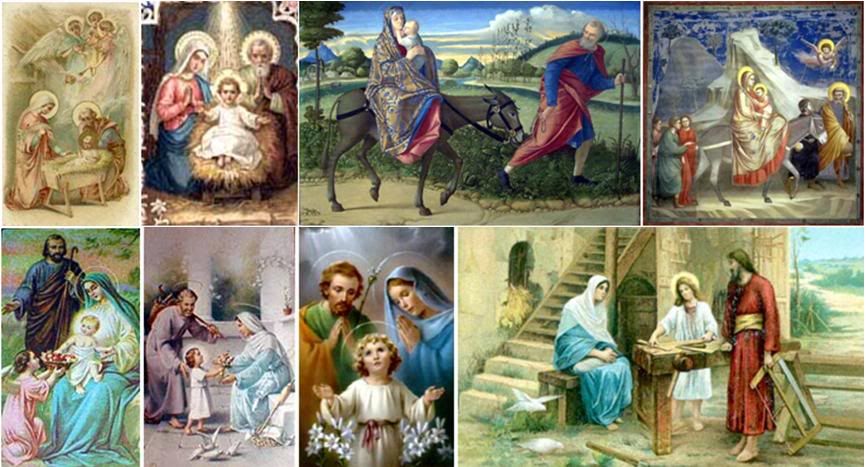 FEAST OF ST. JOHN THE EVANGELIST
FEAST OF ST. JOHN THE EVANGELIST
 Many historians and Biblical scholars will continue to insist that John the Beloved Disciple was not John the Evangelist, but in the popular mind and in Christian tradition, he is one and the same. Depictions of John through the ages alternate between showing him as a young man, as Guido Reni, Pedro Berruguete, an unknown contemporary painter, and El Greco do in the panel above; or as venerable sage, as in the Giotto (extreme left) and traditional image (extreme right).
Many historians and Biblical scholars will continue to insist that John the Beloved Disciple was not John the Evangelist, but in the popular mind and in Christian tradition, he is one and the same. Depictions of John through the ages alternate between showing him as a young man, as Guido Reni, Pedro Berruguete, an unknown contemporary painter, and El Greco do in the panel above; or as venerable sage, as in the Giotto (extreme left) and traditional image (extreme right).
Apparently, there was no OR on Sunday, because all the events starting from Christmas Eve are reported in tomorrow's double issue for 12/28/-12/29.
THE POPE'S SUNDAY
Holiday Angelus on the Holy Family - with a special message to the annual 'Family Day' mammoth rally
by the Catholics of Madrid.
Lunch at the Trastevere soup kitchen of the Sant'Egidio Community.
|
| |
 29/12/2009 06:46 29/12/2009 06:46 |
|
| | | OFFLINE | | Post: 19.168
Post: 1.812 | Registrato il: 28/08/2005
Registrato il: 20/01/2009 | Administratore | Utente Veteran | |
|


 THE SUNDAY ANGELUS
THE SUNDAY ANGELUS
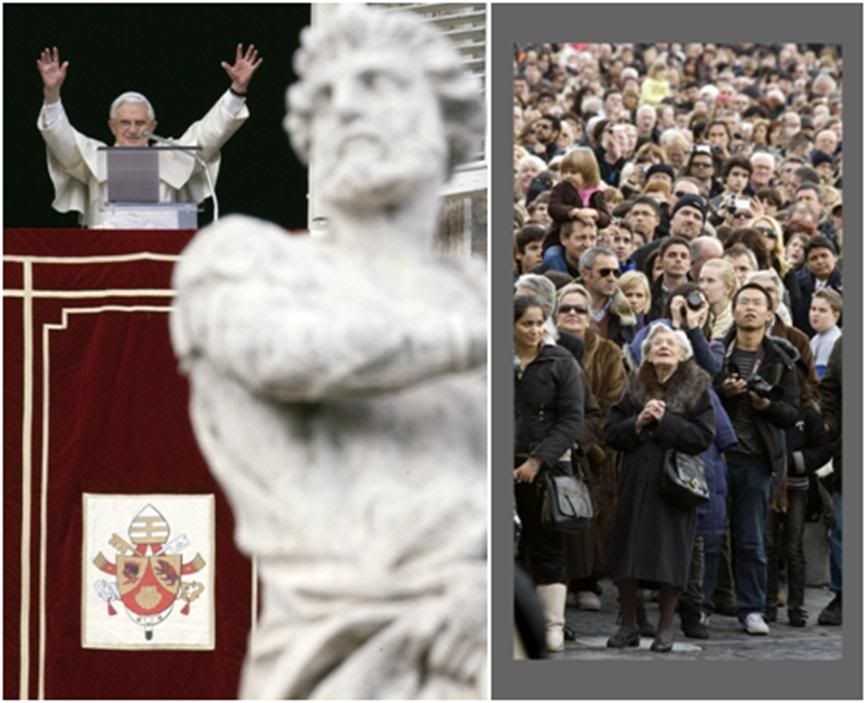
On Sunday, the Holy Father led the noontime Angelus as usual at St. Peter's Square, before leaving for the soup kitchen of the Sant'Egidio Community in the Trastevere district, where he sat down to lunch with Sant'Egidio leaders and the homeless who are the regular beneficiaries of this assistance.
Here is what he said in English:
Today we celebrate with joy the Feast of the Holy Family, who shared with us this fundamental human experience.
I pray that the Lord may bless all Christian families and assist them in living their daily life in mutual love and in generosity to others, after the example of Jesus, Mary and Joseph.
May Almighty God continue to bless you all with peace and joy during this Christmas Season!
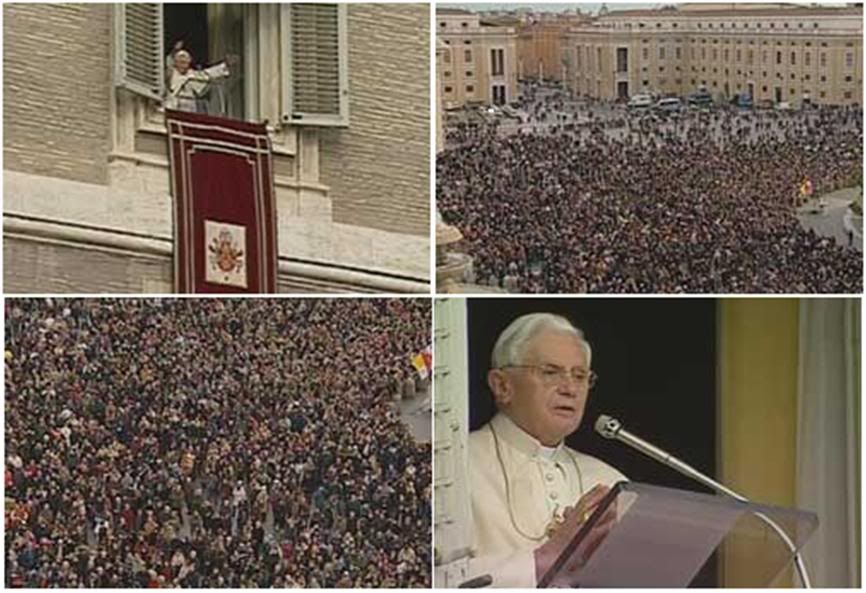
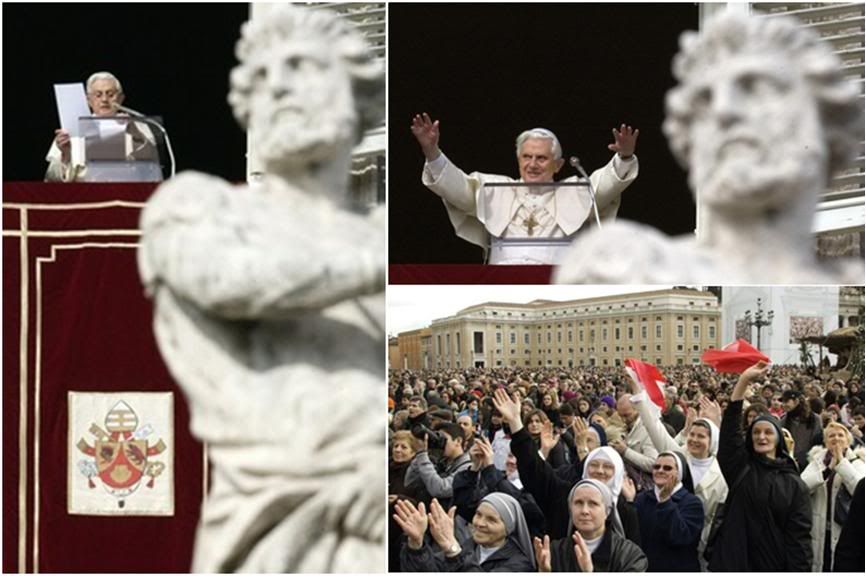 Here is a translation of the Holy Father's little homily before the Marian prayer:
Here is a translation of the Holy Father's little homily before the Marian prayer:
Dear brothers and sisters:
Today is the Sunday of the Holy Family. We can still identify ourselves with the shepherds of Bethlehem, who, upon hearing the announcement of the angels, ran in haste towards the cave in Bethlehem and found "Mary and Joseph and teh Baby ling in a manger" (Lk 2,16).
Let us pause ourselves to contemplate that scene, and let us reflect on its meaning. The first witnesses of the birth of Christ, the shepherds, found themselves not only in front of the Baby Jesus but of a small family: mother, father and a newborn son.
God wished to reveal himself by being born to a human family, and therefore, the human family has become an icon of God! God is Trinity, he is a communion of love, and the family, despite all the difference that exists between the mystery of God and his human creature, is an expression that reflects the unfathomable mystery of God-Love.
Man and woman, created in the image of God, become 'one flesh' in matrimony (Gen 2,23), that is, a communion of love that generates new life. The human family, in a certain sense, is an icon of the Trinity, for its inter-personal love and the fecundity of that love.
The liturgy today offers the famous Gospel episode of the twelve-year-old Jesus who stays behind in the Temple in Jerusalem, unknown to his parents, who, astounded and concerned, found him after three days disputing with the doctors of the Temple.
To his mother who asks him for an explanation, Jesus replies that he must be 'in his Father's house', that is the house of God (cfr Lk 2,49). In this episode, the boy Jesus appears to us full of zeal for God and for his Temple. Let us ask ourselves: From whom did Jesus learn to love the 'things' of his Father?
Certainly, as the Son, he had an intimate knowledge of his Father, of God, a profound and permanent personal relation with Him, but in his concrete culture, he had certainly learned the prayers, love for the Temple and the institutions of Israel from his own parents.
Therefore, we can affirm that the decision of Jesus to stay behind in the Temple was, above all, the result of his intimate relation with the Father, but also of the education he had received from Mary and Joseph.
Here we can see the authentic meaning of Christian education: that it is the fruit of a collaboration that must always be sought between educators and God. The Christian family knows that children are a gift and a plan of God.
That is why, they cannot be considered possessions, but serving in them the plan of God, it is called to educate them to the greatest freedom, which is that of saying Yes to the will of God. The Virgin Mary gives the perfect example of this Yes. Let us entrust to her all families, and pray specially for their precious educational mission.
And now, I will address, in Spanish, those who are taking part in the Feast of the Holy Family in Madrid:
I greet warmly the pastors and faithful who are assembled in Madrid to celebrate the Holy Family with joy. How can we fail to recall the true meaning of this celebration?
God, having come into the world, in the bosom of a family, manifests that this institution is a sure way to meet and know him, as well as a permanent call to work so that everyone is united in love.
Thus, one of the best services that we Christians can do for our contemporaries is to offer them our firm and serene testimony of the family founded on matrimony between a man and a woman, protecting and promoting it, because it is of supreme importance for the present and future of mankind.
Indeed, the family is the best school where one learns to live those values that dignify a person and make peoples great. In it we share our sorrows and joys, feeling that we are all clothed with that love that reigns in a home by the mere fact of being members of the same family.
I pray to God that your homes may always breathe that love of total abandonment and fidelity that Jesus brought to the world with his birth, nourishing and fortifying it with daily prayer, the constant practice of virtues, reciprocal understanding anc mutual respect.
Thus I urge that, trusting in the maternal intercession of the Most Blessed Mary, Queen of Families, and in the powerful protection of St. Joseph, her spouse, you dedicate yourself tirelessly to this beautiful mission that the Lord has placed in your hands.
You may count on my closeness and affection, and I ask you to bring a very special greeting from the Pope to your loved ones and those who are most needy or who find themselves in difficulty. I bless you all from the heart.
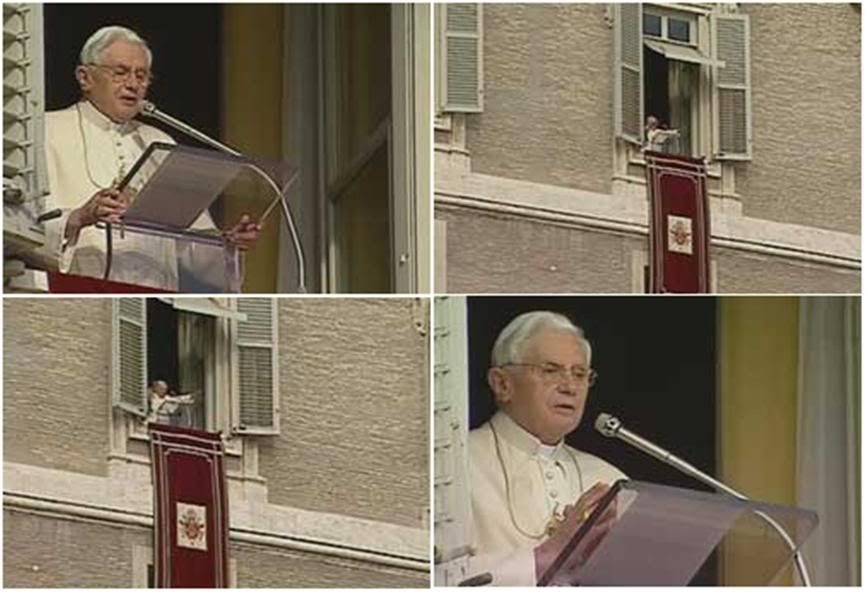
 |
| |
 29/12/2009 11:14 29/12/2009 11:14 |
|
| | | OFFLINE | Post: 200
Post: 8 | Registrato il: 28/05/2007
Registrato il: 19/02/2009 | Utente Comunità | Utente Junior | |
|
I must say, I was a tad concerned about you... ![[SM=g7564]](https://im0.freeforumzone.it/up/0/64/3018036.gif)
Good to have you back. In the meantime I've been hit with a human virus and have not been able to get out of bed for the last four days (as always: if it hits you, it hits you hard).
Thanks for all your efforts!! Have a wonderful New Year!
![[SM=g9433]](https://im0.freeforumzone.it/up/0/33/2103559.gif)
 Dear Heike,
Dear Heike,
Thanks for your kind concern. I know the holiday season was marked by your Mom going home to the Father, but we mortals do feel the pain of earthly loss, even when our loved ones have gone to a better place. I commiserate additionally that you also caught a virus in addition to everything else.
I hope the bad bug gets squashed by your system and that, well and at peace, you will welcome in a blessed and prosperous New Year for yourself and those you love. God bless....
TERESA
[Modificato da TERESA BENEDETTA 29/12/2009 15:34] |
| |
 29/12/2009 11:48 29/12/2009 11:48 |
|
| | | OFFLINE | | Post: 19.169
Post: 1.813 | Registrato il: 28/08/2005
Registrato il: 20/01/2009 | Administratore | Utente Veteran | |
|




 Obviously a belated post, but it was a great photo opportunity for everyone concerned!.
THE POPE'S CHRISTMAS VISIT
Obviously a belated post, but it was a great photo opportunity for everyone concerned!.
THE POPE'S CHRISTMAS VISIT
TO A SOUP KITCHEN IN ROME
 Pope presses on in first trip
Pope presses on in first trip
outside Vatican since Mass attack

VATICAN CITY, Dec. 28 (AP) - Pope Benedict XVI waded into a crowd of well-wishers in Rome yesterday, just days after he was knocked down by a woman at a Christmas Eve Mass.
It was the 82-year-old Pontiff’s first appearance outside the Vatican since the attack, which left him unhurt but raised security concerns.
The Vatican said it would review security procedures but could not ensure the pope’s security 100 percent because he is regularly surrounded by tens of thousands of people for his weekly audiences, Masses, papal greetings and other events.
Security was tight but Benedict greeted well-wishers as usual. He kissed some children and caressed the hands of others as he entered a soup kitchen operated by the Sant’Egidio Community, a lay Catholic group based in Rome, a few miles from the Vatican.
Many in the crowd applauded, some shouting “Viva il Papa!” or “Long Live the Pope!”
The Pope has kept up his busy holiday schedule despite the incident, in which a woman jumped a barricade in St. Peter’s Basilica and pulled the pope to the ground as she was taken down by guards.
Benedict got up quickly and celebrated the Mass. The next morning, he delivered his traditional Christmas Day message.
The Vatican said the woman was mentally unstable and identified her as 25-year-old Susanna Maiolo, a Swiss-Italian national. She remains in a clinic for treatment.
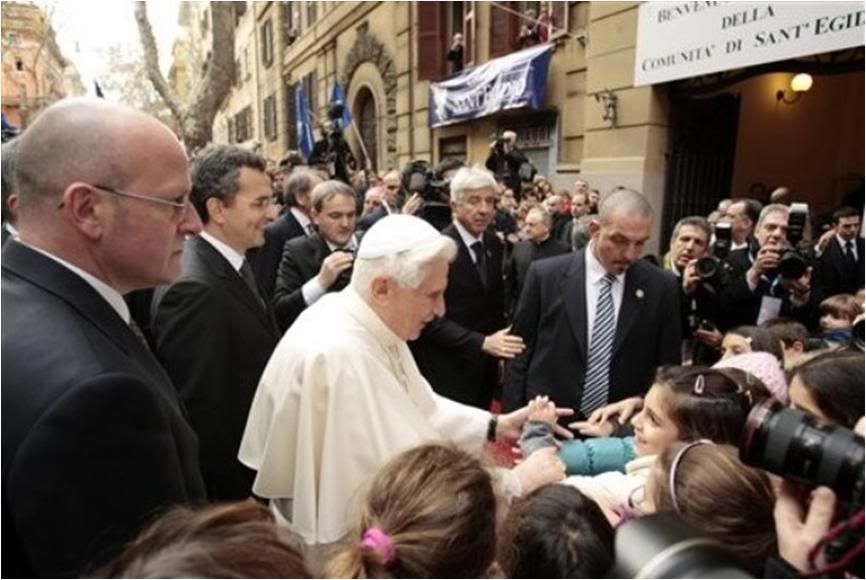
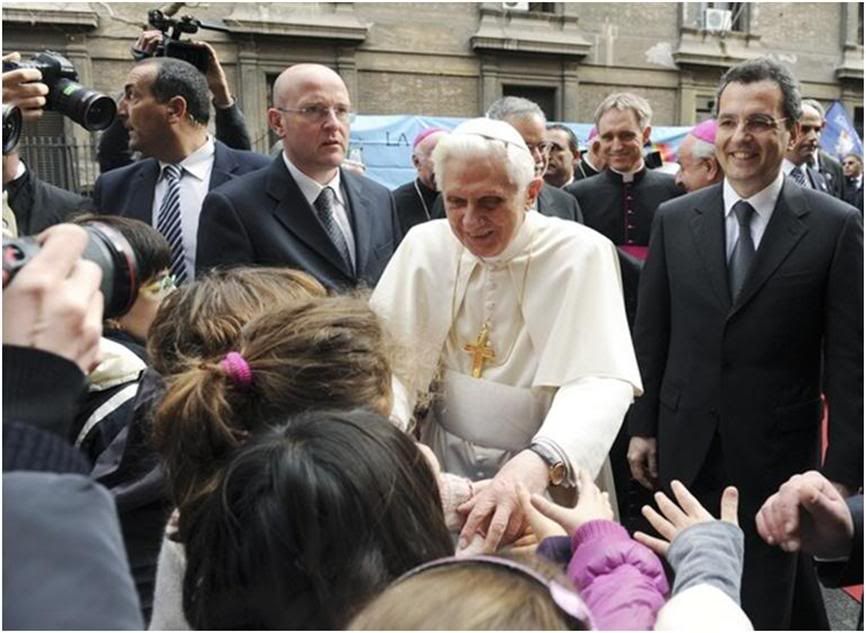

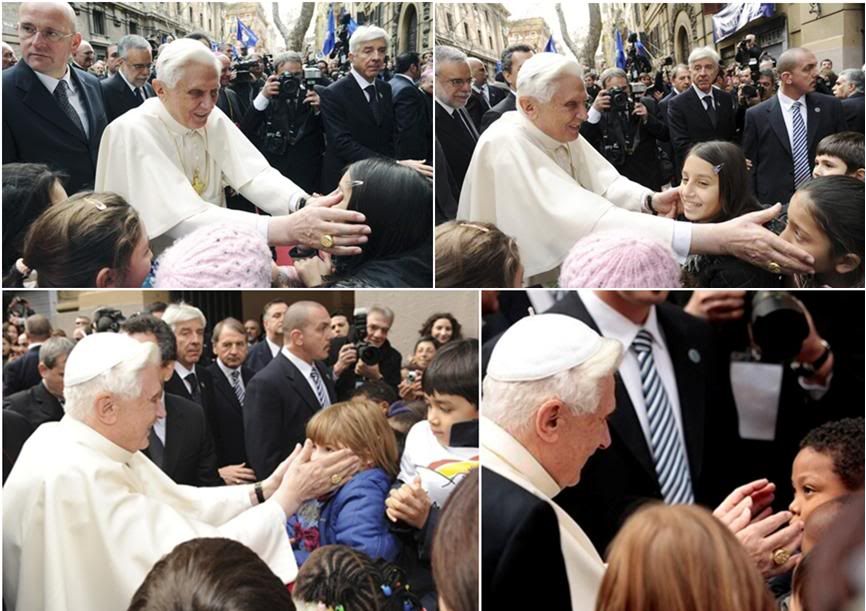
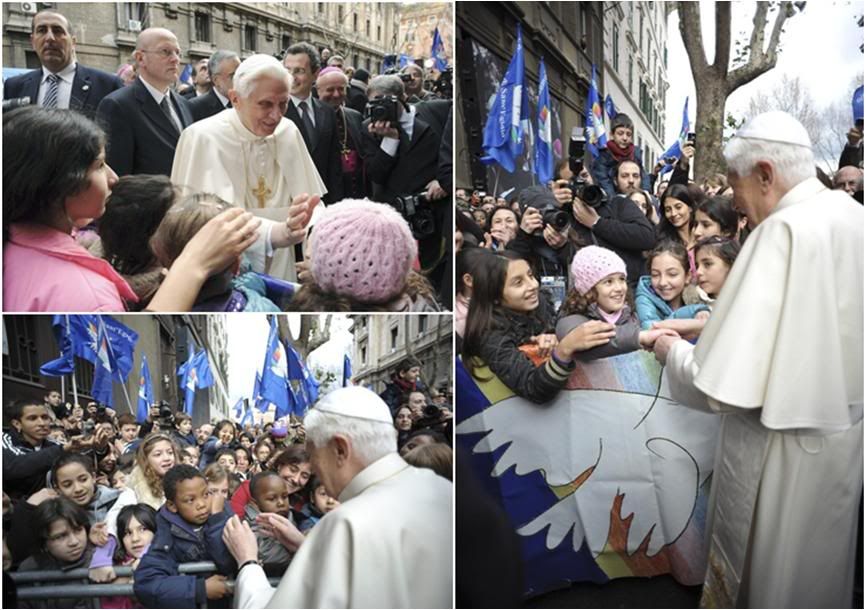 The visit
Translated from
The visit
Translated from

Dec. 27, 2009
At 1 p.m. today, Feast of the Holy Family, the Holy Father Benedict XVI went to the mess hall on Via Dandolo in Trastevere to have lunch with representatives of the various groups assisted by the Community of Sant'Egidio.
On his arrival, the Pope was welcomed by members of the Community led by its founder, Prof. Andrea Riccardi; and by Mons. Luigi Moretti, vice-regent of the Diocese of Rome, and Mons. Vincenzo Paglia, Bishop of Terni-Narni-Amelia.
In the dining hall, after the prayer of benediction, the Pope was formally welcomed in remarks by Prof. Riccardi, after which they sat down to lunch. The Pope and Riccardi were seated with 12 of the Sant'Egidio wards at lunch.
Before dessert, the Holy Father addressed the gathering. Afterwards, the children present sang a Christmas song for him, and the Pope handed out presents to each of them.
Finally, in an adjoining hall, the Pope met with a group of 30 immigrants who are taking Italian language lessons for free with the Sant'Egidio Community.
Outside, he also greeted all those who had been unable to be accommodated within the dining hall and who waited to see him.
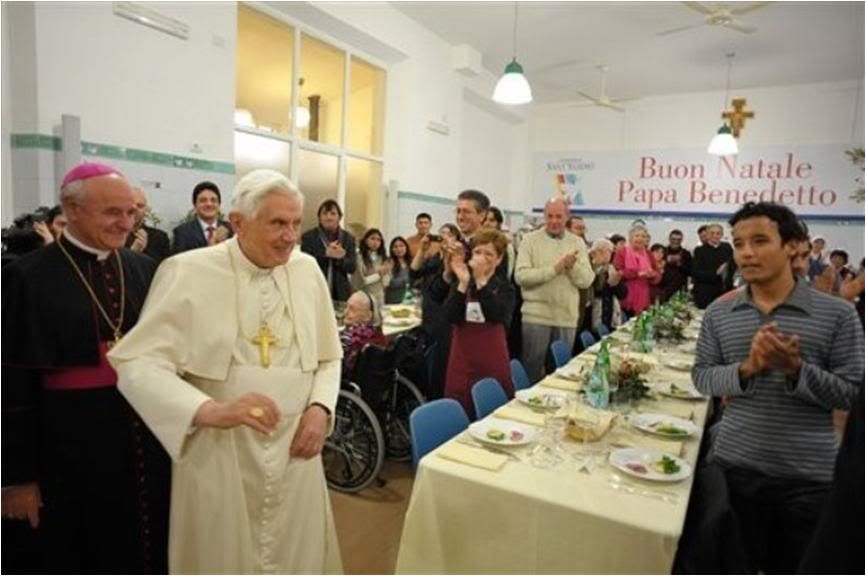

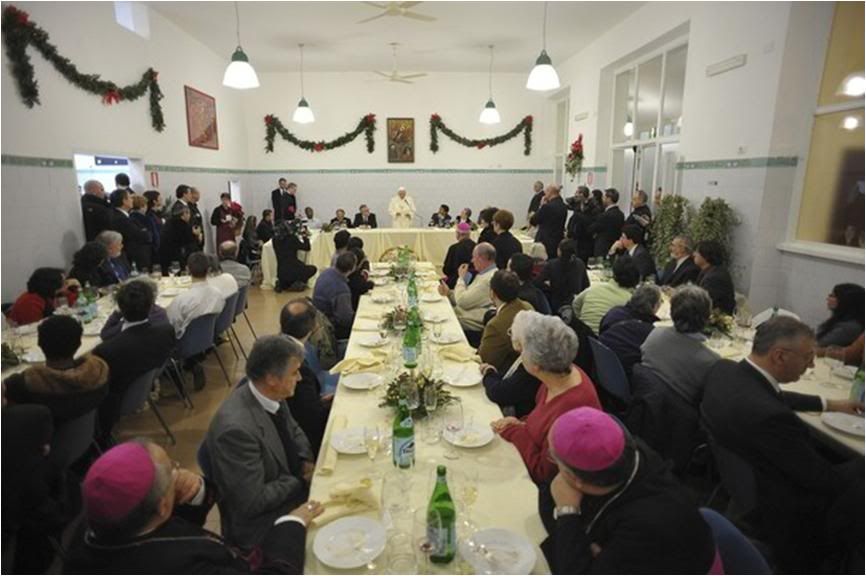

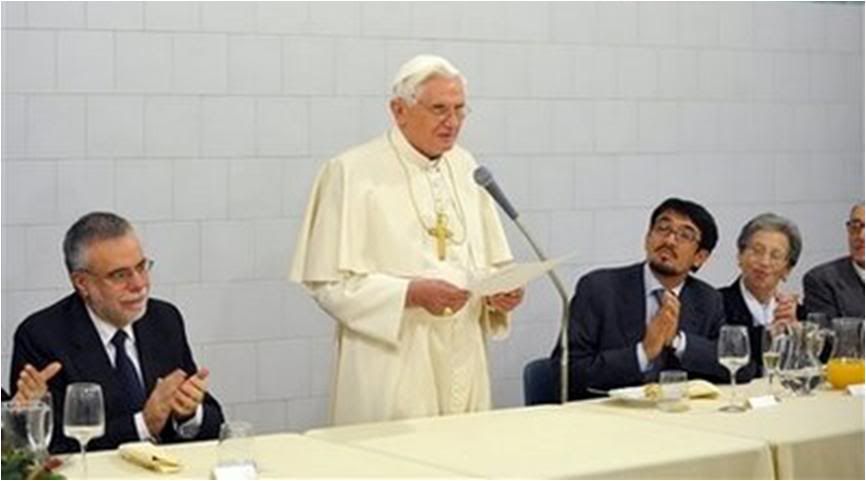 Here is a translation of the Pope's 'after lunch' remarks:
Here is a translation of the Pope's 'after lunch' remarks:
Dear friends:
It is a very moving experience for me to be with you, here in the family of the Sant'Egidio Community, to be with friends of Jesus, who has a special love for persons who suffer, for those in difficulty, and wishes to have them as brothers and sisters. Thank you for this opportunity.
I am very happy and I thank all those who, with love and competence, prepared the meal - I truly appreciate their competence with the cuisine, my compliments! - and those who served so efficiently so that we finished a great meal in an hour. Thank you and congratulations!
I address an affectionate thought to the Vice-Regent, Mons, Luigi Moretti, and to Mons. Vincenzo Paglia, Bishop of Terni-Narni-Amelia. And an affectionate greeting to Prof. Andrea Rcciardi, founder of the Community - a longtime friend, as are Mons. Paglia and Mons. Spreafico - with thanks for the cordial words they addressed me.
And with Prof. Riccardi, I greet the president of the Commmunity, Prof. Marco Impagliazzo, and the parish priest of Santa Maria in Trastevere, Mons. Matteo Zuppi.
Finally, I greet all the friends of Sant'Egidio and each of you present. Over lunch, I was able to learn a bit about the stories of some among you, as a reflection of the human situations represented here, as well as stories of rediscovering love here at Sant'Egidio: experiences of older people, of immigrants, homless people, gypsies, disabled persons, those in economic and other difficulties - everyone,in one way or another, sorely tried by life.
I am here with you to tell you I am close to you and I love you, that your persons and experiences are not far from my thoughts. You are at the center and the heart of the Community of Sant'Egidio, just as you are in my heart.
The gestures of love by those who follow Jesus make visible the truth that "God loved us first and continues to love us first - for which we too can respond with love" (Deus caritas est, 17).
Jesus said, "For I was hungry and you gave me food, I was thirsty and you gave me drink, a stranger and you welcomed me, naked and you clothed me, ill and you cared for me, in prison and you visited me." (Mt 25,35-36), concluding, "Whatever you did for one of these least brothers of mine, you did for me'" (v. 40).
Listening to these words, how can we not feel that we are truly friends to those in whom the Lord recognizes himself? Not just friends, but family members.
I have come to visit you precisely on the Feast of the Holy Family because, in a way, they were like you. Indeed, the family of Jesus, from the very start, had difficulties: they lived through the discomfort of not finding hospitality, they were forced to emigrate to Egypt because of the violence of King Herod.
You know very well what such difficulties mean, but you now have someone who loves you and helps you. Each of you has found a family here, thanks to the attentive services of the Community of Sant'Egidio which offers a sign of God's love to the poor.
What happened here today is like what happens at home: those who serve and help, together with those who are served and helped, and given first place is he who is most in need.
An expression from the Psalms comes to mind: "How good it is, how pleasant, where the people dwell as one!" (Ps 133,1).
The commitment to make those who are alone or in need feel that they are part of a family - so praiseworthily carried forward by the Community of Sant'Egidio - is born from attentive listening to the Word of God and from prayer. I wish to encourage everyone to persevere in this way of faith.
With the words of St. John Chrysostom, I wish to remind each of you: "Remember that you become priests of Christ, when you give with your own hands, not flesh but bread, and not blod, but a glass of water" (Homily on the Gospel of Matthew, 42,3).
What riches the love of God offers to life, a love expressed in concrete service towards our brothers who are in need! St. Lawrence, Deacon of the Church of Rome, when the Magistrates of his time threatened him in order that he would give up the treasures of the Church, indicated to them the poor people of Rome as the true treasure of the Church. Remembering St. Lawrence's gesture, we can well say that you are indeed the precious treasure of the Church.
To love and to serve gives us the joy of the Lord, who says: "It is more blessed to give than to receive" (Acts 20,35). At this time of particular economic difficulties, may each one be a sign of hope and witness for a new world to those who, enclosed in their own selfishness and deluded that they can achieve happiness by themselves, really live in sadness or in an ephemeral joy which leaves the heart empty.
A few days ago, we observed the Holy Nativity: God became a Baby, he came near to us to tell us he loves us and that he needs our love.
I wish everyone affectionately happy holidays and the joy of experiencing ever more the love of God.
I invoke the protection of the Virgin of the Visitation, who teaches us to go 'in haste' towards our needy brothers, and I bless you all with affection.
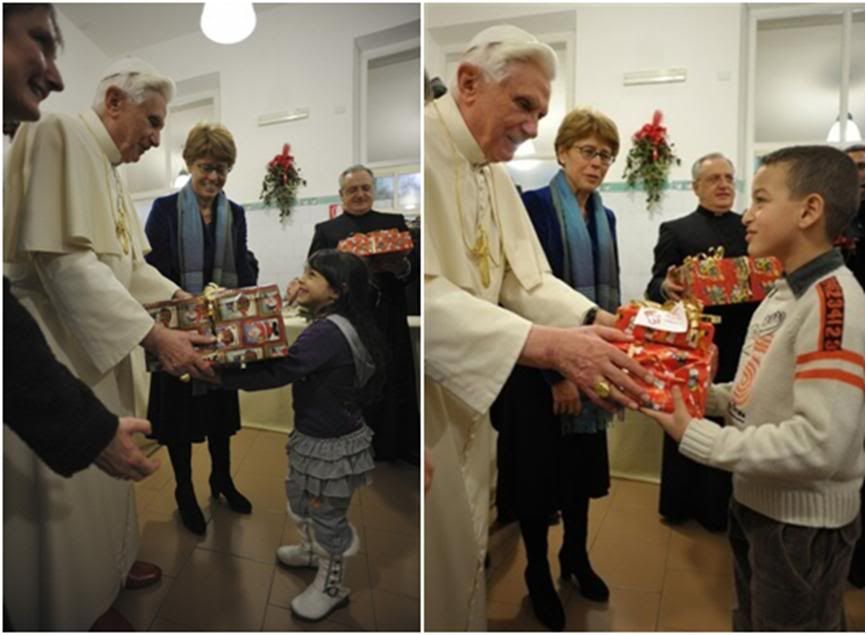
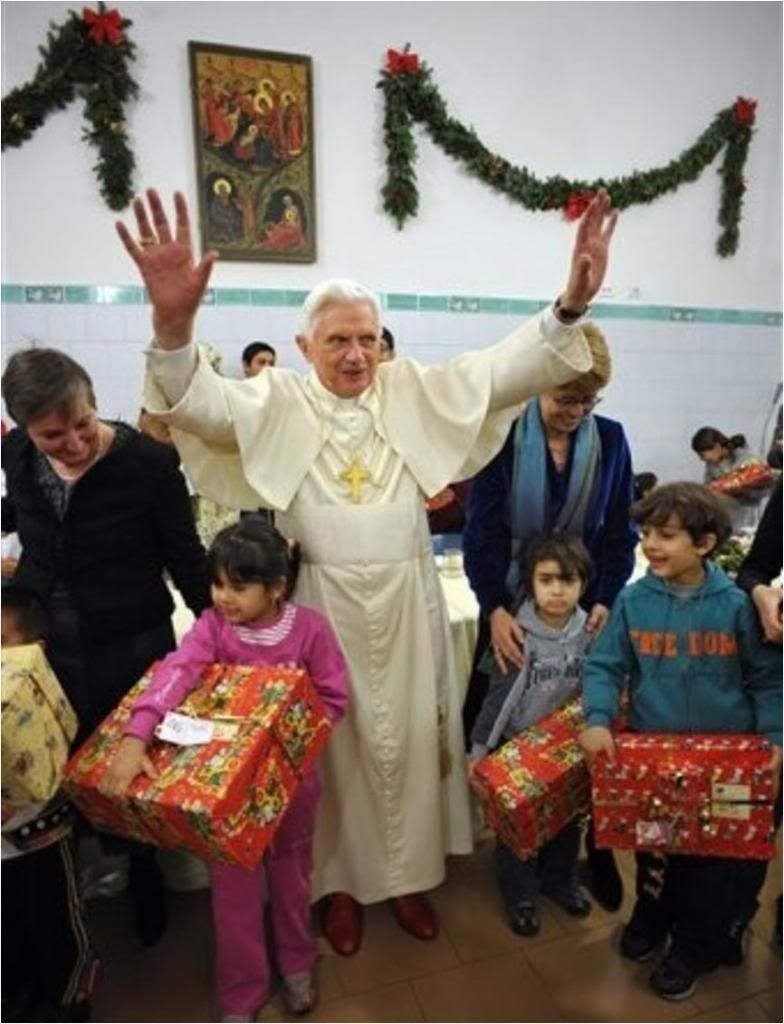
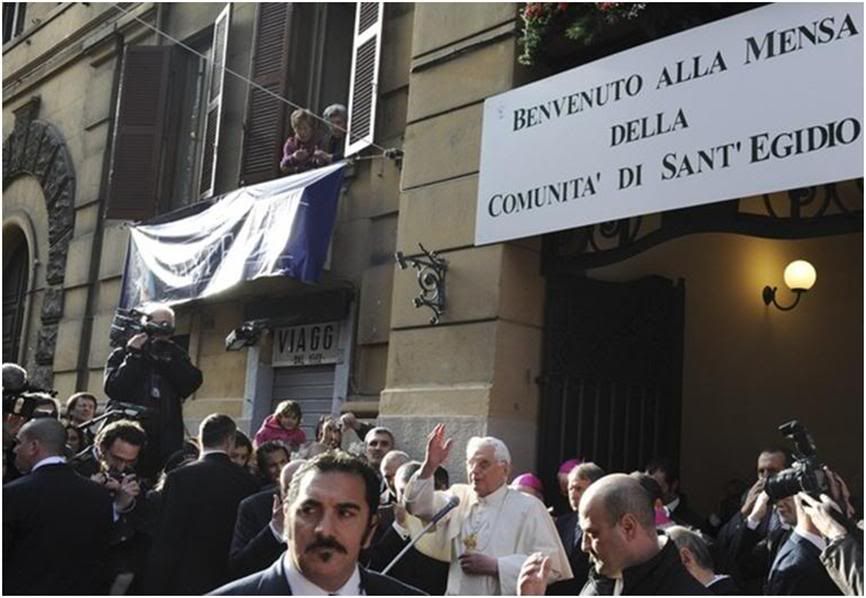
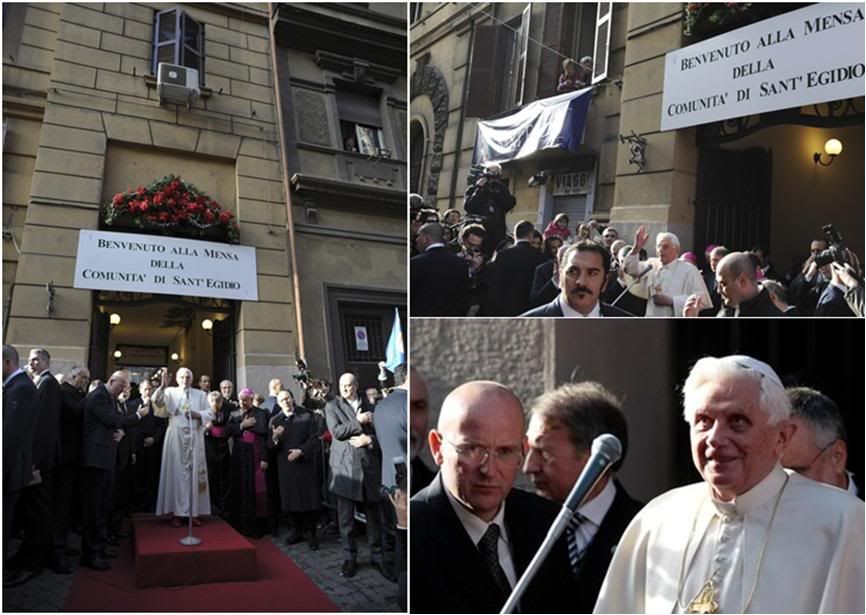 Here is a translation of what the Pope said:
Here is a translation of what the Pope said:
Dear brothers and sisters,
Aftr having taken part in the festive lunch at the dining hall of the Sant'Egidio Community, and having greeted some students of the school for language and culture here, I greet with warmest wishes those who were unable to enter the building but who took part in this encounter from outside - I am told for an hour or two. Thank you!
So many people, coming from various nations, and driven by need, find themselves here to find a welcome word, some assistance, some light towards a better future. As the Apostle Paul said: "If I speak in human and angelic tongues but do not have love, I am a resounding gong or a clashing cymbal" ( 1 Cor 13, 1).
This, too, is the language of this school, which we must learn to practice increasingly. It is taught to us by the Baby Jesus, God who became one of us for love, and speaks to us above all through his presence, his humility of being a Baby who makes himself dependent on our love. This language of love makes our city and the world better.
I bless you all affectionately and thank you for what you do for others in the work of building a civilization of love. Thank you to everyone.
Happy holidays and a Happy New Year!
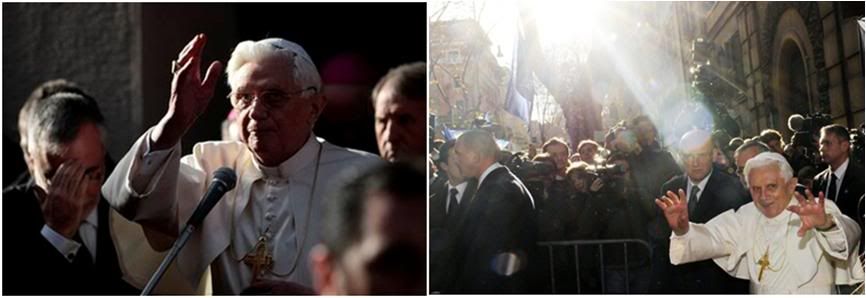
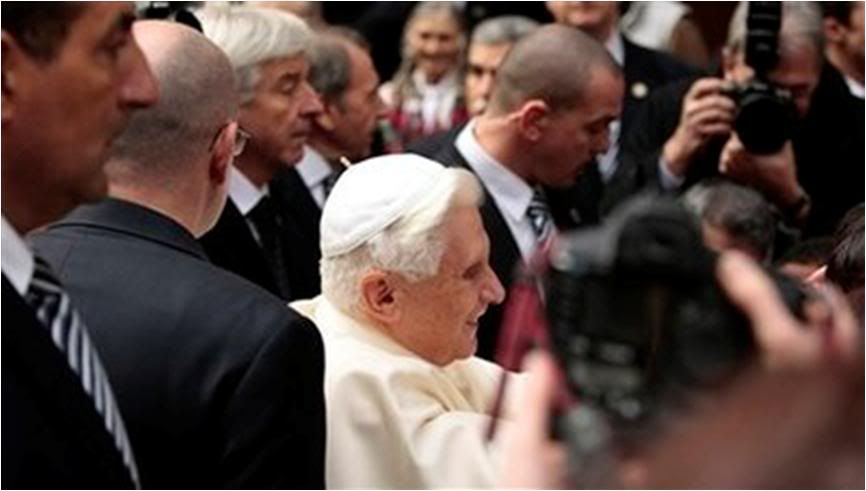 The photos we get from the news agencies never tell the complete story, of course, often missing the most significant ones, as with this story, for which I cannot find a single photograph to illustrate it...
Benedict XVI reaches out
The photos we get from the news agencies never tell the complete story, of course, often missing the most significant ones, as with this story, for which I cannot find a single photograph to illustrate it...
Benedict XVI reaches out
to Rome's 'marginal' people
by LUCA BRUGNARA
Translated from
Translated from

Dec. 28, 2009
"He embraced me, and after listening to my situation, he murmured that he would pray for me - I will never forget this day".
The emotion expressed by Godwin, a Nigerian, was shared by the more than 150 like him who lunched Sunday with Pope Benedict XVI in Sant'Egidio's soup kitchen in Via Dandolo,
It was the first time that a Pope had done this, joining people with diverse life stories and origins, young and old, who were all moved by the personal interest that the Pope took in each of them.
"He has given me courage," Godwin adds. He came to Italy 10 years ago, and now works as a doorman in one of the Sant'Egidio Community's facilities. "It is an experience I will carry in my heart all my life. I never thought I could have such an intense emotion."
The Pope had circulated among the tables, wanting to hear the stories of his 'lunchmates', to speak to them and comfort them. To his right at table sat the founder of the Community, historian Andrea Riccardi [who was a 19-year-old university student when he founded Sant'Egidio], and to his left, Qorbanali Esmaili, Afghan, Shiite Muslim and political refugee.
"It's the first time a religious leader has listened to me, and above all, he dwelt on the difficulties of refugees around the world," Esmaili said. "He asked me to tell him my story - it was very moving, we spoke quite a while, and maybe, we will meet again".
Qorbanali has been in Italy ten years and was homeless for a long time.
Also at the head table, which sat 14, was Boban Trajkovic, a Romanian gypsy, who is an orthodox Christian, with his wife Dragana and 3-year-old daughter Claudia.
"The Pope urged us never to be discouraged," he said. "I was much struck by his simplicity and humanity".
The lunch lasted 45 minutes, with antipasto, lasagna, meatballs, lentils and mashed potatoes, and festive panettone (Italian raisin bread) and spumante (Italian sparkling wine), with a final toast.
"One sees the cooks are quite competent," Papa Ratzinger jested later, thanking those who are used to cooking at least a thousand meals everyday.
"He was very kind," said Paola, one of the cooks. "I've never cooked for a Pope!"
Everyone present had his own story to tell.
"He approached me," says Marisa Saule, an 82-year-old Roman native. "He asked about me, and then he joked about our age, saying we were both from 'the class of 1927' - a class of iron, he said". Marisa, who statred workign when she was 10, was the oldest woman present.
Then there was Peppino Scarsella, a 90-year-old widower, who lives in the Tiburtino area [one of Rome's large suburban train and Metro stations].
"All my life, I was a barber, and now I depend on Sant'Egidio for assistance because my pension is scant. It is the first time I have seen a Pope close up - and it is one of the most beautiful moments in my life."
The Pope spoke to each of them. "He wanted to know how I live," said Aniello Bosco, 25, who has been handicapped from birth. "He comforted me, recalling what the Gospel says. He showed a humanity that I had not expected".
There were 31 children among the lunch guests - and each of them got a present from the Pope.
"I never thought a Pope would be interested in my personal life," said Giuseppe Pisu. "He listened to the problems I had from when in 1980, I was in Tehran with my travelling circus, and war erupted between Iran and Iraq... It is a day I never ever expected to experience".
[Modificato da TERESA BENEDETTA 31/12/2009 14:22] |
| |
 29/12/2009 12:45 29/12/2009 12:45 |
|
| | | OFFLINE | | Post: 19.170
Post: 1.814 | Registrato il: 28/08/2005
Registrato il: 20/01/2009 | Administratore | Utente Veteran | |
|


 Messori asks Pope for
Messori asks Pope for
a 'Ratzinger Report-II' and...
Translated from


Dec. 28, 2009
My day to work today in the Foglio newsroom. I wrote an article for the Tuesday paper on the Belgian theologian Edward Schillebeeckx who died this weekend, and to do so, I spent some minutes on the phone with Vittorio Messori who gifted me with a disclosure that I will write about for the paper.
"I'm doing this as a gift to you," he said. "It's Christmas and we all need to do a good deed", as we spoke about his 1984 interview book Rapporto sulla Fede (The Ratzinger Report, in English) with Cardinal Ratzinger.
Here is part of our dialog:
PR: Have you ever thought of updating the book?
VM: I've thought about it. And I even told the Pope.
PR: When?
VM: Recently. I sent him a copy of my latest book Perche credo (Why I believe), and Mons. Gaenswein called me to express the Pope's thanks. I took advantage to tell him I would love to meet with the Pope - I must say that, out of discretion, I have never asked to do this since he became Pope. Don Georg said the simplest way to do that was to come to a Wednesday audience.
So I did that. With Andrea Tornielli, who wrote the book with me [Tornielli was the interviewer), we were given seats near where the Pope would give his catechesis in St. Peter's Square. When the Pope drove up in the Popemobile, he saw me and he greeted me by raising his arm. Later, when he came to our sector, he approached me and we chatted a while.
I reminded him that it has been 25 years since Rapporto was published.
"Hard to believe!", he exclaimed.
"True!... Isn't it time for a Rapporto II? If you give me three days, we can do as we did in Bressanone in 1984 and the book will be done."
"Three days? But, Dottore, I don't even have three hours! However, I promise you I will think about it."
Then he moved on, but after taking a few steps, he turned back and said, "I don't even have three hours!"
[Modificato da TERESA BENEDETTA 28/12/2010 10:27] |
| |
 29/12/2009 14:40 29/12/2009 14:40 |
|
| | | OFFLINE | | Post: 19.171
Post: 1.815 | Registrato il: 28/08/2005
Registrato il: 20/01/2009 | Administratore | Utente Veteran | |
|


 Tuesday, December 29
Tuesday, December 29
 ST. THOMAS BECKET (England, 1118-1170), Lord Chancellor of England, Archbishop of Canterbury, Martyr
ST. THOMAS BECKET (England, 1118-1170), Lord Chancellor of England, Archbishop of Canterbury, Martyr
Modern literature, theater and cinema have made Becket's story familiar to the general public, and his dramatic 'murder in the cathedral' of Canterbury was long a subject for painters. He was a gifted man whom Henry II chose to his Lord Chancellor, and to whom he sent his son and heir to live with and be raised, in the custom of the day. But the King and his Chancellor soon came into conflict over the rights and privileges of the Church, and Becket was assassinated by followers of the king. He was canonized barely three years after he died. After Henry VIII set up his own Church in the early 16th century, Becket's tomb in Canterbury Cathedral was among those desecrated in the anti-Catholic frenzy that ensured, and even his bones were destroyed.
OR for 12/28-12/20/09.
This is the first issue of OR since Christmas Eve, so it contains the reportage and papal texts from all the events starting with Christmas Eve Mass and the Maiolo incident.

During the festivities of the Nativity, Benedict XVI renews
the appeal to reject the logic of violence and vendetta:
'A Baby's power for peace'
 Right photo above shows the Pope unveiling a marker of his visit to the Sant'Egidio soup kitchen, where he also visited an attached language school that teaches Italian to new immigrants.
Right photo above shows the Pope unveiling a marker of his visit to the Sant'Egidio soup kitchen, where he also visited an attached language school that teaches Italian to new immigrants.

No events scheduled for the Holy Father today.
[Modificato da TERESA BENEDETTA 29/12/2009 16:53] |
| |
 29/12/2009 19:13 29/12/2009 19:13 |
|
| | | OFFLINE | | Post: 19.172
Post: 1.816 | Registrato il: 28/08/2005
Registrato il: 20/01/2009 | Administratore | Utente Veteran | |
|
 Pope chooses Salesian priest
Pope chooses Salesian priest
to preach 2010 Lenten exercises
Translated from

dEC. 29, 2007
Salesian priest Fr. Enrico del Covolo has been chosen by Pope BVenedict XVI to preach the Lenten spiritual exercises for the Pope and the Roman Curia in 2010, it was learned yesterday from the Salesian information office.
The seven-day spiritual retreat is held during the first week of Lent at the Redemptoris Mater chapel of the Apostolic Palace.
Fr. del Covolo, 59, is the Postulator-General of the order founded by St. John Bosco (the Postulator General internally oversees the causes of Salesians nominated for beatification and canonization). He is also a tenured professor of ancient Christian literature at the Pontifical Salesian University.
A member of the Pontifical Committee on Historical Sciences, he has been a consultant to the Congregation for the Doctrine of the Faith since 2002.
He is the third Salesian called to carry out this special assignemnt. In 1997, Paul VI chose Fr. Antonio Javiarra Ortas, then rector of the Salesian university in Rome, later named cardinal; and in 1986, John Paul II chose Fr. Egidio Vigano, another rector.
Benedict XVI has so far chosen four emeritus ardinals - Marco Ce of Venice, 2005; Giacomo Biffi of Bologna, 2006; theologian Albert VanHoye, 2007; and Francis Arinze of Nigeria, 2008.
In the Year for Priests, he has decided to name a priest.
Both John Paul II and Benedict XVI preached the Lenten exercises as cardinals.
|
| |
 29/12/2009 20:28 29/12/2009 20:28 |
|
| | | OFFLINE | | Post: 19.173
Post: 1.817 | Registrato il: 28/08/2005
Registrato il: 20/01/2009 | Administratore | Utente Veteran | |
|

 Benedict XVI and the faithful:
Benedict XVI and the faithful:
Undaunted by St. Peter's incident -
and rightly so
by Luigi Accattoli
Translated from

Dec. 28, 2009
I know at least three quotations pertinent to the Pope's fall on Christmas Eve in St, Peter's - and the most appropriate was from John Paul II: "No place is more dangerous than St. Peter's Square".
He said this in reply to a French cardinal who thought it might not be advisable for him to visit Lyons in 1986, after much chatter about a Nostradamus prophecy that such a trip would be 'unfortunate'.
Benedict XVI could update his predecessor's statement by adding St. Peter's Basilica to St. Peter's Square.
The second quotation has to do with the 'mission impossible' of Vatican security.
"Either a Pope defends himself on his own, or no one can defend him", said Cardinal Dino Monduzzi, then Papa Wojtyla's Prefect of the Pontifical Household, speaking of the Turkish would-be assassin Ali Agca.
Obviously, as long as the Pope ventures into the world, it will not be possible to prevent a madman or someone with bad intentions from targeting him sooner or later.
The third quotation comes from the former Vatican spokesman Joaquin Navarro Valls, who states the obvious limitation of the 'papal self-defense' advocated by Cardinal Monduzzi. [Besides the fact that self-defense does not come with the Pope's job description, and in any case, no one expects any man older than 70 to defend himself as if he were a judo blackbelter like Vladimir Putin!]
"The Pope cannot be invisible", Navarro Valls says. I heard him say that to those who lamented the public exposure of Papa Wojtyla in the final years, especially when he was already suffering visibly from the signs of Parkinson's disease.
For 76 years now, the Popes have left the Vatican to go forth among the people, placing themselves at risk, but also the crowds among which they find themselves.
Pius XII was the first to do so, with his wartime visits to the Roman neighborhoods of San Giovanni and San Lorenzo after the Allied bombardments in June and August of 1943.
And it is beautifully fitting that the most reclusive of the 20th century Popes was the first to meet the people - in his case, to show solidarity with Roma's residents who were terrorized by the bombardments. [Rome was supposed to be an 'open city' during the war, not to be subjected to air raids and artillery because of the unique historical and cultural value of its monuments, buildings and works of art.]
John XXIII substantially increased the papal visits within Rome and Italy. Paul VI extended them to the five continents, and John Paul II with his globetrotting made every country his own.
Benedict XVI inherited their desire to get close to the faithful. With the Popes Pacelli, Roncalli, Montini, Luciani, Wojtyla and Ratzinger, the Roman Pontificate broke centuries-old papal tradition to revert to the original adventure of 'missione ad gentes' which is also an encounter with the world.
The assassination attempt on John Paul II in 1981 and every other risk taken by the Bishops of Rome in the past decades are part of that encounter.
The attempt against John Paul II created the sensation of constant potential danger every time the Pope leaves the Apostolic Palace, a danger that is theoretically known to all.
Paul VI was almost crushed by a crowd in Jerusalem in 1964, and lightly injured when a Bolivian painter dressed as a priest rushed to stab him after he had stepped off the airplane in Manila in 1970 [the man was fortunately stopped in time].
But no one had imagined that any such attempt would take place in St. Peter's Square itself. The blood shed by John Paul that day served to immensely magnify the vigilance around the Pope, and the media became more interested in his movements outside the Vatican because of the potential danger.
Thew new vigilance was immediately apparent on October 4, 1981, when John Paul II first returned to St. Peter's Square after the May attempt on his life: The entire perimeter demarcated by the Bernini colonnades was barricaded. Each one entering that perimeter had to go through a metal detector and frisking.
But Papa Wojtyla and his successor have not held themselves away from the crowds.
One result of the fear syndrome was the Popemobile with its bulletproof glass and chassis, which has been in use since 1981 in various configurations.
Giani Baget Bozzo once wrote that the Popemobile was the new sedia gestatoria. [the portable papal throne last used by John XXII - it is borne on the shoulders of selected attendants so they can hold the Pope above the heads of the crowd and enable everyone to have a good view of him.
After the Christmas Eve incident in the Basilica, Benedict XVI will be forced to use the enclosed Popemobile more frequently, as John Paul II did in the years following Agca's attempt.
It will be good that he does so, and that every form of prevention be taken by those responsible for his security.
But it is also good and right that Benedict XVI continues to go forth among the faithful. Up till now, we have been fortunate that only 'simple folk' have tried to accost his person in unusual ways: On July 9, 2006, in Valencia; on September 12, 2006 in Regensburg; and on June 6, 2007, in St. Peter's Square. [And of course, Susana Maiolo's two consecutive Christmas Eve 'attacks' in St. Peter's]
[I am familiar with the June 2007 incident involving the German man who tried to jump the Popemobile, But I don't think I ever read about the incident in Valencia or in Regensburg, on the very day yet that he gave his earth-shaking lecture!]
So it was with pleasure that I watched Papa Ratzinger on Sunday among the crowd during his visit to the Sant'Egidio soup kitchen.
Holiness, go on doing so: our frightened world today needs your example of serenity in relating to others.
[Modificato da TERESA BENEDETTA 29/12/2009 21:03] |
| |
 29/12/2009 22:41 29/12/2009 22:41 |
|
| | | OFFLINE | Post: 2.304
Post: 40 | Registrato il: 27/11/2005
Registrato il: 21/01/2009 | Utente Comunità | Utente Junior | |
|
Thank you, Teresa, for all your additional reporting here and I trust you are having a holy Christmas season, despite your computer problems.
Thanks especially for those beautiful pictures of the Holy Family.
![[SM=g9433]](https://im0.freeforumzone.it/up/0/33/2103559.gif)
 Thanks a lot, Mary. Despite unusually cold weather (21 degrees today), New York at Christmastime is always a wonderful place to be in. the only inconvenience I really mind is to have no Internet access on a holiday weekend, and therefore unable to keep up with B16 news the way I have become habituated (and addicted) in the past almost five years!! I wish you and Hutch all the best in the coming year. God bless....
Thanks a lot, Mary. Despite unusually cold weather (21 degrees today), New York at Christmastime is always a wonderful place to be in. the only inconvenience I really mind is to have no Internet access on a holiday weekend, and therefore unable to keep up with B16 news the way I have become habituated (and addicted) in the past almost five years!! I wish you and Hutch all the best in the coming year. God bless....
TERESA
[Modificato da TERESA BENEDETTA 30/12/2009 07:19] |
| |
 30/12/2009 07:05 30/12/2009 07:05 |
|
| | | OFFLINE | | Post: 19.174
Post: 1.818 | Registrato il: 28/08/2005
Registrato il: 20/01/2009 | Administratore | Utente Veteran | |
|

 I have posted commentary a couple of times before by this writer who submitted the following essay to Lella's blog.
The 'simplicity and hiddenness'
I have posted commentary a couple of times before by this writer who submitted the following essay to Lella's blog.
The 'simplicity and hiddenness'
of the Ratzinger Pontificate
by Roberto Pepe
Translated from

Dec. 28, 2009
I, too, was there in St. Peter's Square, seated near some young Mexicans who had positioned themselves opposite the central Loggia of St. Peter's basilica one hour earlier, singing and waving flaglets - and we were there to see our Grande Papa, after that violent attempt to 'embrace' him the night before, but above all, to hear his words to the city and to the world, on the day of universal love.
"All about there was darkness, while in the cave there shone the true light “that enlightens every man” (Jn 1:9). And yet all this took place in simplicity and hiddenness, in the way that God works in all of salvation history. God loves to light little lights, so as then to illuminate vast spaces".
Such are the clear words that distinguish the Pontificate of Papa Ratzinger. "Simple and hidden'- words that may first seem like feeble lights, though attention-getting for those who immediately perceive what they mean - and then, as needed, the light expands, and enlightens with unprecedented power.
"Today too, on behalf of a human family profoundly affected by a grave financial crisis, yet even more by a moral crisis, and by the painful wounds of wars and conflicts, the Church, in faithful solidarity with mankind, repeats with the shepherds: “Let us go to Bethlehem”, for there we shall find our hope... inviting its people to abandon every logic of violence and vengeance, and to engage with renewed vigour and generosity in the process which leads to peaceful coexistence".
At this point, the Pope, taking up his previously expressed clear advocacy in defense of Christianity and the Catholics of the world, argues that many times, in the past, because of the pragmatism of 'international political relativism', there has been silence - in order not to hurt the 'otherness' of non-Christians, or because of the unacknowledged fear of appearing like the stereotyped evangelizers in conquered countries...
Benedict XVI has in the past openly denounced the dangerous attempts at violent Islamization in some zones of Central Africa that had been shamefully abandoned after forced decolonization by Soviet and Latin American guerrilla armies singing hymns to secular Marxist thought, then replaced after its ideological dissolution by Islamist fundamentalist terrorism....
The Pope, thanks to the simplicity and linear logic of his own limpid thinking - that is above any political order and is not aimed at any interference in national affairs - has the right to condemn the evil they have perpetrated on their own fellow Muslims as well as the faithful of other religions around the world.
Therefore, he spoke up 'humanly' and 'religiously' in behalf of the 'tiny flock of Christians' who live in tribulation in Iraq not to mention the persecuted Churches "in Sri Lanka, the Korean peninsula and the Philippines..."
For the African continent, he has tirelessly called for an end to every aggression in the Democratic Republic of the Congo; he asks the citizens of Guinea and Niger to respect human rights for everyone and to engage in dialog; to the people of Madagascar, "to overcome their internal divisions and to accept each other reciprocally".
Speaking to the West, particularly Europe and North America, he underscores the need "to overcome selfish technological mentality, to promote the common good, and to respect the weakest members of society, starting with those who are yet to be born".
And for Latin America, he reiterates the commitment of the Church to help Honduras "resume its institutional way". Indeed, he says, in all of Latin America, the Church is an identifying factor that represents the fullness of truth and charity that no ideology can replace.
We can be sure that his subject of evangelization and the defense of the Christian-Catholic identity, will be the 'substantia' that will dominate thinking in the Vatican, insistently and tenaciously - without that hesitation dictated by clamorous forces extraneous to religious apologetics, but which unfortunately clutter up the minds of many grim thinkers who, however, lack the simplicity and reserve in this Pope which can kindle those indispensable little lights that may be feeble at first but tenacious.
[Modificato da TERESA BENEDETTA 30/12/2009 17:33] |
| |
 30/12/2009 08:16 30/12/2009 08:16 |
|
| | | OFFLINE | | Post: 19.175
Post: 1.819 | Registrato il: 28/08/2005
Registrato il: 20/01/2009 | Administratore | Utente Veteran | |
|



 I decided to post this story apart from the main post about the Pope's visit to the Sant'Egidio soup kitchen last Sunday because it is such a rare story - the kind I had been hoping to read but somehow never found, from those lucky young people chosen to lunch with Benedict XVI in Cologne and in Sydney. It is probably the most 'intimate' experience any outsider can have with a Pope - to be able to share a meal with him. It is a wonderful testimonial about Benedict XVI.
The joy of a young handicapped man
I decided to post this story apart from the main post about the Pope's visit to the Sant'Egidio soup kitchen last Sunday because it is such a rare story - the kind I had been hoping to read but somehow never found, from those lucky young people chosen to lunch with Benedict XVI in Cologne and in Sydney. It is probably the most 'intimate' experience any outsider can have with a Pope - to be able to share a meal with him. It is a wonderful testimonial about Benedict XVI.
The joy of a young handicapped man
who lunched with the Pope
by Giacomo Galeazzi
Translated from

Dec. 29, 2009
ROME - "It was the most beautiful day of my life", said Aniello Bosco, a 20-year-old congenitally handicapped young man in a wheelchair, who had been abandoned by his family at birth and raised all his life by the Sant'Egidio Community.
He was one of the eleven persons who sat at the same table with Benedict XVI and two Sant'Egidio officials on Sunday at the Community's soup kitchen on Via Dandolo in Trastevere.
"As we ate, the Pope told me he was happy to be with us - he spoke as if he knew us all, and the atmosphere was joyous. It really seemed like a table of frinds," Aniello said.
Among the poor, vagrants, gypsies, and homeless, the Pope remarked he 'felt at home' - And Aniello became a river in flood as he mentally played back the details of his 'special day'. He seemed stilll unable to take it all in and he erupts with an exclamation: "Incredible!"
"I thought that Popes were distant figures, unapproachable, but Benedict XVI immediately was 'in tune' with us. Unbelievably, we felt he was a friend, a neighbor, a colleague, who was ready and willing to interact".
Aniello came away with a portrait of Joseph Ratzinger as "a kind man, gentle and serene... a particularly sensitive and respectful person". In short, "he seemed one of us, very much on hand".
"He looks you straight in the eye, he knows how to listen, and to say words that go to your heart".
And so, emotion adds to the amazement. Aniello says he was particularly moved when the Pope said the Church would always be on the side of 'the least' and that "he would always be with us, praying for us".
'Truly emotional', 'a familial atmosphere', 'a celebration among friends', were phrases Aniello used to describe his experience, but also "a historic event, the first visit of a Pope to this institution".
Aniello, for whom Sant;Egidio had been 'home' almost from the day he was born, had been designated to speak in behalf of the Sant'Egidio beneficiaries after lunch, to thank the Pope for "this most beautiful day'.
"As a child, I had to be kept in the hospital a long time. Later, I went to live in the Rome suburb of Tor Bella Monaca, where I attended a public school with other children of the Sant'Egidio community, with whom I developed profound friendships. For us, Sant'Egidio was salvation," Aniello recalls. "This has become my family, and for is to be together today with the Pope is an indescribable joy."
His life has taught him that "anyone with problems and difficulties can face it well only by living in community, or a family. It is the only way to live happily from day to day."
He calls it "a response to loneliness, a way for us to help each other, be close to each other, and be mutually encouraging".
To the Pope, Aniello described the pain and sorrow of having been abandoned, and how subsequently, "At Sant'Egidio, I found constant support in all my difficulties - to be housed in a community facility where I found the warmth of a family".
His day consists of going to a handicapped center for training in the mornings and then, staying home in the afternoon with his fellow wards. "We are never bored because we have so many activities. Living together in this community house, we know what it means to help and sustain each other", he told the Pope.
The Pope listened more than he spoke, Aniello observed, and he appreciated that later. the Pope stopped to admire the creche at the mess hall and at the marker dedicated to Modesta Valenti, a homeless woman who died in Rome's main train station and considered a symbol of Rome's homeless people.
In the Pope's presence, Aniello said, "I felt myself enveloped by a wave of affection and attention. His look seems to read within you, he understands what his closeness means to you, makes you feel he is truly the father to everone, starting with those who most need one. I will never forget his words, and the participation with which he listened as we told him of our life in the community".
Thus for Aniello, Benedict XVI is 'the father of everyone and each one" in whom "solidarity and charity begin with a caress".
The story is also a beautiful tribute to the Sant'Egidio Community - and to all the charitable institutions and persons around the world - who serve Christ and the Church by serving people in need. Truly inspiring, and deserving of our thanks, prayers and support.
[Modificato da TERESA BENEDETTA 30/12/2009 08:21] |
| |
 30/12/2009 08:34 30/12/2009 08:34 |
|
| | | OFFLINE | | Post: 19.176
Post: 1.820 | Registrato il: 28/08/2005
Registrato il: 20/01/2009 | Administratore | Utente Veteran | |
|

 BEST VIDEO SO FAR
BEST VIDEO SO FAR
OF THE CHRISTMAS EVE 'ATTACK'

has a clean new video of the Christmas Eve aggression which shows how quickly Domenico Giani, the Pope's chief security officer, to the left of the Pope, got hold of Susanna Maiolo almost as soon as she jumped in front of the Pope, but somehow she still managed to grab the Pope's pallium (we don't see this, since the video is shot from the 'rear' of the procession) before she is subdued.... The 'action' comes around 0:32 seconds into the clip and is then replayed in slow-mo.
www.romereports.com/palio/modules.php?t=New-exclusive-video-of-attack-on-Pope-Benedict-XVI-at-Christmas-Eve-Mass&name=News&file=article&newlang=english&...
Here are two videocaps I attempted to capture the 'moment':
 On this Reuters videocap strip, Giani's body completely blocks the woamn from view.
On this Reuters videocap strip, Giani's body completely blocks the woamn from view.
 In this connection, there was this thoughtful commentary in the Tuesday issue of Avvenire on how 'the Church' - mainly the Vatican and the Italian bishops conference - has reacted to Susana Maiolo's action.
A lesson from the Vatican:
In this connection, there was this thoughtful commentary in the Tuesday issue of Avvenire on how 'the Church' - mainly the Vatican and the Italian bishops conference - has reacted to Susana Maiolo's action.
A lesson from the Vatican:
The overflowing force of compassion
by ROBERTO MUSSAPI
Translated from

Dec. 29, 2009
A lesson from the Vatican and the Church.
A lesson with metamorphical capacity - that is, to work or favor a positive metamorphosis, towards good, towards fullness.
A prototype, a model to imitate, for those with the right spirit, to be able to transform water to wine, or to multiply bread and fish.
Cardinal Angelo Bagnasco, president of the Italian bishops' conference (CEI), commenting on the episode against the person of the Pope, described the attacker, in effect, as a woman who was 'excessive' in her desire to get close to the Pope.
Statements from the Vatican implicitly ask that the young woman be looked on as a person who needs to be healed rather than punished, and because of that, Vatican justice will be swift and light.
Also good sense, the reader may comment, since basically, it appears evident that the young woman, Susana Maiolo, had no violent intentions. And if only out of common sense, it is not worthwhile to dwell further on this episode.
How many governments, entities, authorities, institutions in the world, could manifest with such naturalness such good sense today - a calm acceptance of what happened, when they are struck, offended, or even simply just barely touched? Common sense is not very common these days, especially when it concerns something that involves one so directly. But that is not the point.
Rather, the Vatican has not responded in an irenic, peace-at-all-costs or even, a goody-two-shoes manner. But it has given a philosophilcal and moral lesson.
The action of a mentally-disturbed young woman resulted in an elderly cardinal who fractured his hip, requiring surgery, and in the fall of the Pope who was unharmed.
But it is absolutely possible to hypothesize that her insane gesture could have caused great harm to a man of Benedict's age who falls suddenly and not gently to the floor, where he could have hit his head.
A lawyer outside the Church would underline that Susanna Maiolo's action was potentially injurious, besides being intrinsically violent although she was unarmed. Because one can do harm with the fists, with pushing, or even with words....
But in the statements from the Vatican, there has been no hint of this second aspect of the episode - that which could have happened if....
But to 're-size' the episode, as the Vatican has done, does not reduce it out of kindess or moderation, but indicates, as though it were obvious and something to be taken for granted, a tendency to forgive which is almost second nature.
Anthropologically - from the perspective of human nature - is it not admirable that such a tendency to forgive can become second nature?
Let us ask the question when someone aggresses us personally.
But there is much more: In ignoring or minimizing the other aspect (the lethal risk, or at least, the potential for serious injury, to an 82-year-old man assaulted so unexpectedly), ignoring it in the name of good faith and the obvious psychological lability ('weakness', speaking Christianly) of the aggressor - a condition immediately acknowledged and generously understood - the Church offers a small lesson in moral alchemy.
This was not a confrontation with evil, certainly, but faced with a psychological disorder, the Vatican has not demonized the episode. Rather, it has chosen to change the whole picture with the overflowing magic of compassion.
A 'companion' commentary by Lucio Brunelli contrasts the recent attacks against Prime Minister Berlusconi and Pope Benedict which, though outwardly similar, have been treated so differently by the objects of aggression.
Another worthwhile commentary is about the contrast in the three days of relentless media play for the Christmas Eve incident and the almost non-coverage by Italian media of the Pope's visit to the Sant'Egidio soup kitchen. I wil translate when I have the chance.
I must also mention that AGI's Vaticanista Salvatore Izzo believes that the best recourse would have been for the the Vatican to hand over Maiolo to the Italian government for appropriate prosecution and presumably, exemplary justice. But what can the Italian system do beyond what the Vatican court may decide, considering that the woman is obviously a psychiatric case? Can an Italian court hold her criminally responsible if her medical case is established?
BTW, I'm still not seeing commentators, Italian or Anglophone, giving the Holy Father credit for his equanimity and near-instantaneous 'recovery' from the suddenness of that attack! And that this fact alone should reassure those who are understandably concerned about his heart condition, as Benefan was quick to observe in the PRF. We have a stout-hearted pope, in more ways than one!
God keeps watch over his Vicar on earth, and, as always, AD MULTOS ANNOS, SANCTE PATER!
[Modificato da TERESA BENEDETTA 30/12/2009 14:11] |
| |
 30/12/2009 12:09 30/12/2009 12:09 |
|
| | | OFFLINE | | Post: 19.177
Post: 1.821 | Registrato il: 28/08/2005
Registrato il: 20/01/2009 | Administratore | Utente Veteran | |
|


 Wednesday, December 30
Wednesday, December 30
 ST. EGWIN (Ecgwine) (England, d 717), Bishop
ST. EGWIN (Ecgwine) (England, d 717), Bishop
Since no image can be found online for the saint, the illustration shows Our Lady of Evesham,
co-patron of the present church of St. Mary and St. Egwin in Evesham, where Egwin had founded
Evesham Abbey in the 8th century on the spot where Our Lady, in a vision, had told him to build
a church. Born of royal blood, Egwin became a Benedictine monk, then Bishop of Worcester, where
he was popular with the people for his charity and fairness, but unpopular with the clergy from
whom he demanded strict discipline. He had to go to Rome to argue his case with Pope Constantine,
and founded Evesham Abbey on his return. It became one of the great medieval Benedictine abbeys.
He died there, and it became a popular pilgrimage spot renowned for many miracles. But it was one
of the Catholic properties destroyed during the Dissolution era following the establishment of the
Church of England, and only its bell tower survives today.
OR today.
 No papal stories today, but a strange editorial choice to lead off with
No papal stories today, but a strange editorial choice to lead off with
'news' about a presumed new approach to terrorism by President Obama -
when almost all the major media in the U.S. are criticizing him for his
seeming detachment from the Christmas Day terrorist attempt, calling it
an 'alleged' incident! But then editor Vian also said in an interview two
days ago with an Italian newspaper that he considered Obama 'the person
of the year' without explaining his choice! In the same interview, he also
makes fun of Pope Benedict's German accent - among many other odd
things that he had to say, including why he decides not to acknowledge
in the newspaper that certain events happen, by simply not reporting them!
THE POPE'S DAY
General Audience today - On his last GA (#44) for 2009, the Pope
spoke about Pierre Lombard, a 12th century Italian-born theologian
who distinguished himself in Paris and was a contemporary of
Bernard of Clairvaux and the other great French theologians of the
era. The Pope wished everyone a Happy New Year.
NB: The weeks during which he did not give a GA were the first week of Lent
when he was on retreat, the time he was on vacation in Les Combes, and
when he was abroad.
The Holy Father's next public liturgy is the end-of-the-year Vespers
of Thanksgiving in St. Peter's Basilica tomorrow afternoon.
Pope mourns death of
emeritus Tokyo cardinal
The Vatican released the text of a telegram sent by the Holy Father
today to the Archbishop of Tokyo expressing his condolence for the
death this morning of Cardinal Peter Seeichi, emeritus Archbishop
of Tokyo. He will be buried on January 5.
TO THE MOST REVEREND
PETER TAKEO OKADA
ARCHBISHOP OF TOKYO
DEEPLY SADDENED TO LEARN OF THE DEATH OF CARDINAL PETER SEIICHI
SHIRAYANAGI, I OFFER HEARTFELT CONDOLENCES TO YOU, THE CLERGY,
RELIGIOUS AND LAITY OF THE ARCHDIOCESE OF TOKYO.
I RECALL WITH GRATITUDE CARDINAL SHIRAYANAGI’S UNFAILING COMMITMENT
TO THE SPREAD OF THE GOSPEL IN JAPAN IN HIS MANY YEARS AS PRIEST
AND BISHOP, HIS WORK FOR THE PROMOTION OF JUSTICE AND PEACE, AND
HIS TIRELESS EFFORTS ON BEHALF OF REFUGEES.
WITH YOU, I PRAY THAT GOD THE FATHER OF MERCIES MAY GRANT CARDINAL
SHIRAYANAGI THE REWARD OF HIS LABORS AND WELCOME HIS NOBLE SOUL INTO
THE LIGHT AND PEACE OF HEAVEN.
TO ALL ASSEMBLED FOR THE SOLEMN MASS OF CHRISTIAN BURIAL, I CORDIALLY
IMPART MY APOSTOLIC BLESSING AS A PLEDGE OF CONSOLATION AND STRENGTH
IN THE LORD.
BENEDICTUS PP. XVI
[Modificato da TERESA BENEDETTA 05/09/2010 04:34] |
| |
 30/12/2009 14:00 30/12/2009 14:00 |
|
| | | OFFLINE | | Post: 19.178
Post: 1.822 | Registrato il: 28/08/2005
Registrato il: 20/01/2009 | Administratore | Utente Veteran | |
|

 GENERAL AUDIENCE TODAY
GENERAL AUDIENCE TODAY
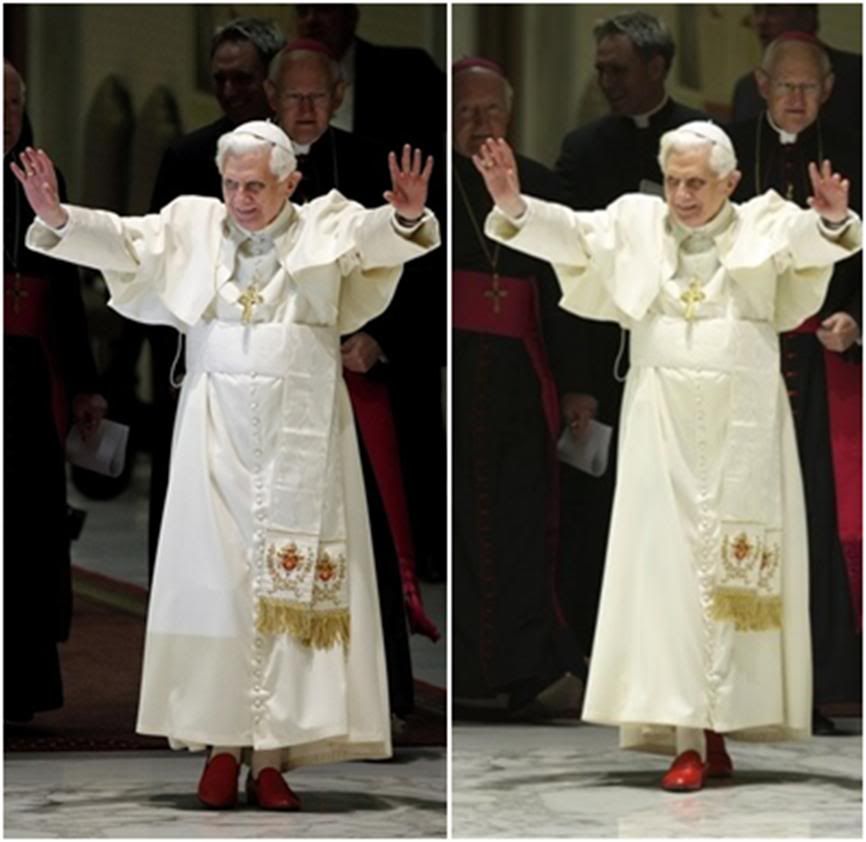
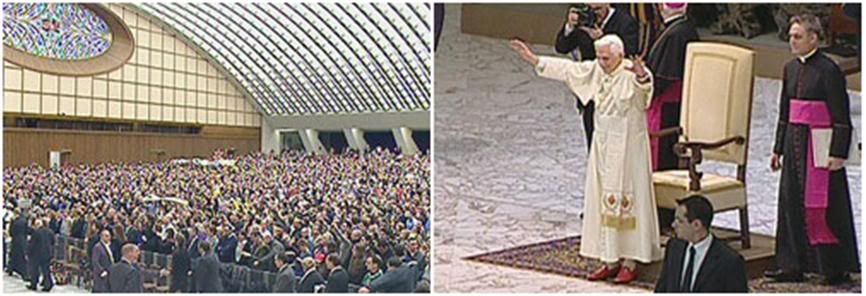
Pope Benedict XVI today gave his last General Audience for 2009 at the Aula Paolo VI and spoke about Pierre Lombard, a 12th century Italian theologian who wrote what would the standard manual for theology over the next four centuries.
Here is how the Holy Father summarized today's catechesis in English:
In our catechesis on the Christian culture of the Middle Ages, we now turn to Peter Lombard, an outstanding theologian of the twelfth century.
Peter taught at the celebrated school of Notre Dame, and died as Bishop of Paris. His best-known work, Sentences, is a collection in four books of patristic texts, carefully selected and ordered for use in the teaching of theology. The Sentences became the standard introduction to theology for centuries, influencing the thought of scholars such as Saints Albert the Great, Bonaventure and Thomas Aquinas.
The Church requires such organic presentations of the Catholic faith, in which each individual article of faith reflects the unity of God’s revealed truth and the majesty of his saving plan.
Peter Lombard’s work thus served a need which, in our day, is also met by the Catechism of the Catholic Church. Among the most enduring contributions of Sentences is Peter’s definition of a sacrament as an outward sign and cause of grace, and his teaching on the sevenfold number of the sacraments.
During this Year for Priests, I encourage priests, as ministers of the sacraments, and all the faithful, to grow in appreciation of the beauty and harmony of our faith, to cultivate the sacramental life, and thus to grow in union with Christ and his Church.
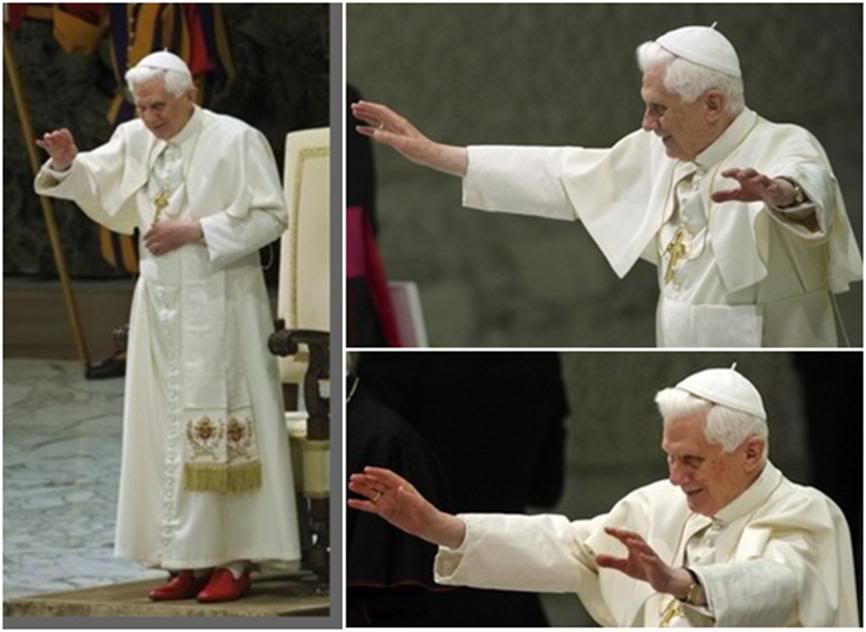
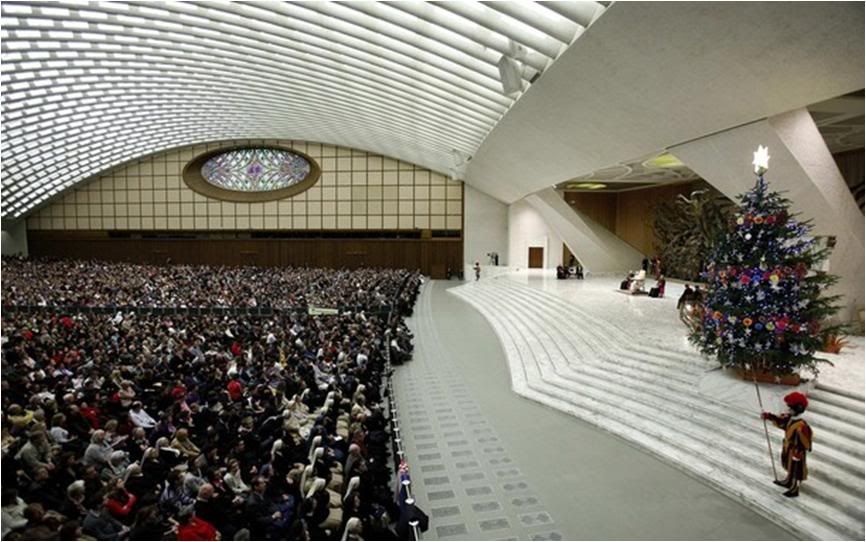
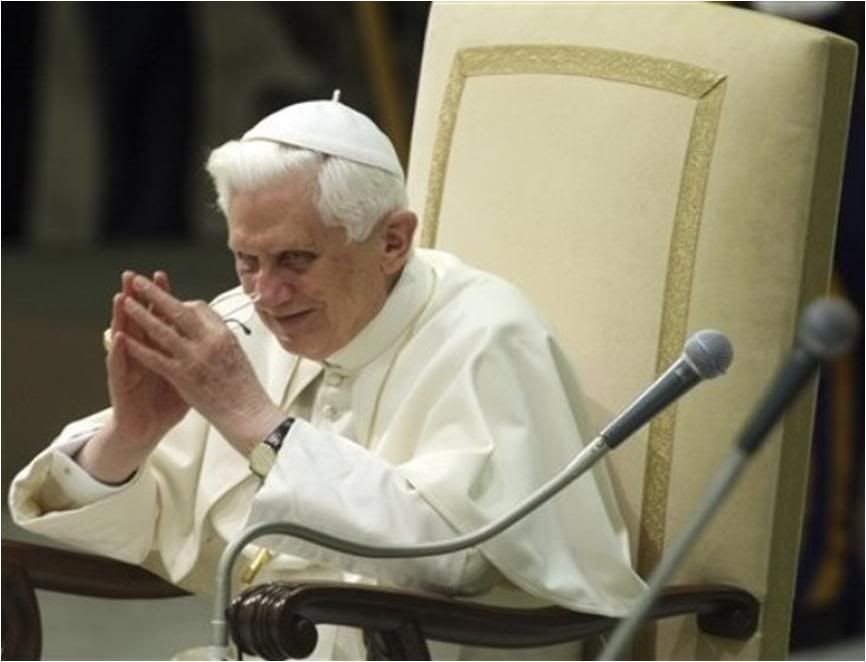
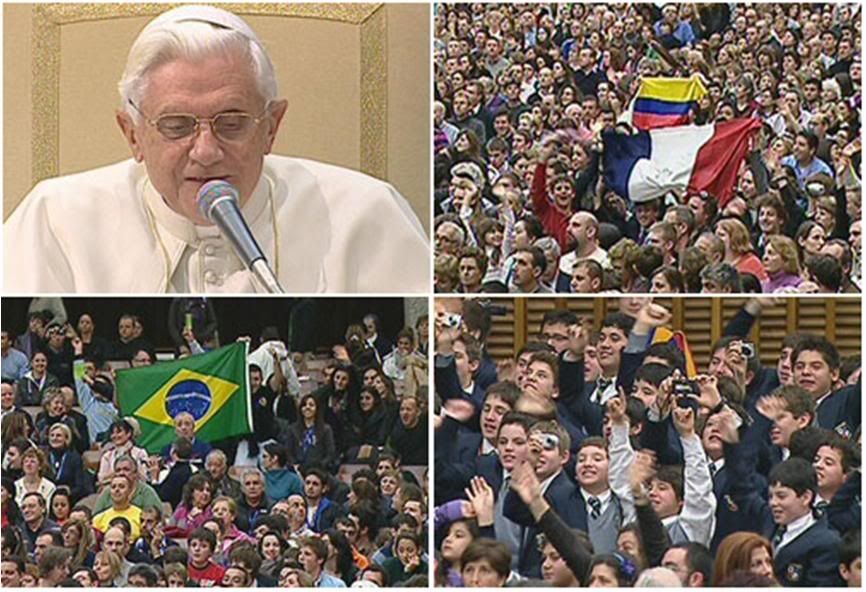 Here is a translation of the full catechesis:
Here is a translation of the full catechesis:
Dear brothers and sisters,
On this last audience of the year, I wish to speak to you about Pierre Lombard (Pietro Lombardo), a theologian who lived in the 12th century and enjoyed great fame because one of his works, entitled Sentences, was adopted as a manual for theology over many centuries.
Who was Pierre Lombard? Although information about his life is scarce, we can reconstruct the essentials of his biography. He was born between the 11th and 12th centuries, near Novara, in northern Italy, within a territory that had belonged to the Longobards for some time - and that is why he was given the appelative 'Lombard'.
He belonged to a family of modest means, as we can deduce from the letter of introduction written for him by Bernard of Cairvaux to Gilduin, superior of the Abbey of St. Victor in Paris, asking him to take in Pietro for free, as the young man wished to go to Paris for further study.
In fact, even in the Middle Ages, it was not just the nobility or the wealthy who could study and acquire important roles in social and ecclesial life, but even persons with humble origins, such as Gregory VII, the Pope who held his ground against [Emperor] Henry IV, and Maurice of Sully, the Archbishop of Paris who ordered the construction of Notre-Dame cathedral and was the son of a poor peasant.
Pierre Lombard began his studies in Bologna, and went on to Rheims, and then Paris. From 1140 onwards, he taught at the prestigious school of Notre Dame. Esteemed and much appreciated as a theologian, he was entrusted eight years later by Pope Eugene III with examining the teachings of Gilbert Porretano which had stirred up much discussion because they were considered unorthodox. Pierre was named Bishop of Paris in 1159, just a year before he died in 1160.
Like all the teachers of theology in his time, Pierre wrote discourses and commentary texts on Sacred Scripture. But his masterpiece consists of the four books of Sentences, a text that was conceived for the purpose of teaching.
According to the theological method used at the time, students had to know, study and comment on the thinking of the Fathers of the Church and other writers considered authoritative. Thus, Pierre assembled a vast documentation, consisting principally of the teachings of the great Latin Fathers, especially St. Augustine, but also open to the contribution of his contemporary theologians.
He also utilized an encyclopedic work of Greek theology, which had only been recently known to the West: The Orthodox faith, by St. John Damascene.
Pierre Lombard's great merit was to have organized all the material that he had gathered and chosen with care into a systematic and harmonious oicture. Indeed, one of the characteristics of theology is to organize the patrimony of the faith in a unified and organized way.
Thus, he distributed the 'sentences' - the patristic sources - into various topics contained in four volumes. The first volume was on God and the Trinitarian mystery; the second, on Creation, sin and Grace; the third, on the mystery of the Incarnation and the work of Redemption, with an ample exposition on the virtues. And the last volume was dedicated to the sacraments and the final realities of eternal life [what Italians call the Novissimi].
The overall vision that emerges includes almost all the truths of the Catholic faith. This synthetic view and its clear, organized, schematic and always consistent presentation explain the extraordinary success of Pierre Lombard's Sentences.
They allowed certainty of learning on the part of students, and an ample space for deeper analysis by the teachers who used the books. A Franciscan theologian, Alexander Hales [an Englishman], who lived one generation after Pierre, introduced a subdivision to the Sentences, which made it easier to consult.
Even the greatest theologians of the 13th century - Albertus Magnus, Bonaventure of Bagnoregio and Thomas Aquinas - began their academic activity by commenting on the four books of Pierre Lombard's Sentences, enriching them with their reflections. Lombard's text was used in all theology schools until the 16th centruy.
I wish to underscore how the organic presentation of the faith is an indispensable requirement. In fact, the single truths of the faith illumine each other, and a total unified view of these truths shows the harmony of God's plan of salvation and the centrality of the mystery of Christ.
Following Pierre Lombard's example, I call on all theologians and priests always to have in mind a full view of Christian doctrine against the dangers of fragmentation and the devaluation of individual truths.
The Catechism of the Catholic Church, as well as its Compendium, offer us this complete picture of the Christian Revelation that we should accept with faith and gratitude.
Thus, I wish to encourage individuals and Christian communities to avail of these instruments in order to know and to look deeper into the contents of our faith. It will appear as a marvelous symphony that speaks to us of God and his love and which will elicit our firm adherence and our industrious response.
To have an idea of the interest that a reading of Pierre Lombard's Sentences can still bring up today, I will give two examples.
Inspired by St. Augustine's commentary on the Book of Genesis, Pierre asks why woman was created from a rib of Adam, not from his head or from his legs. He explains: "What came forth was not a dominator nor a slave to man, but rather, a companion" (Senteza 3, 18,3).
Then, still on the basis of Patristic teeching, he adds: "This act represents the mystery of Christ and thehurch. Indeed, just as woman was formed from Adam's rib as he slept, so the Church was born from the sacraments that began to flow from the rib of Christ as he 'slept' on the Cross, from blood and water, with which we are redeemed from punishment and purified of sin" (Sentenza, 3, 18,4).
These are profound reflections that are still valid today when the theology and spirituality of Christian matrimony have greatly deepened the analogy to the spousal relationship between Christ and his Church.
In another passage from his principal work, Pierre Lombard, writing about the merits of Christ, asks: "For what reason, then, did Christ wish to suffer and die, if his virtues were sufficient to gain him every merit?" His response is incisive and effective: "(He died) for you, not for himself!"
Then he continues with another question and answer, which seem to reproduce the discussions held during the lessons of medieval theologians: "What does it mean that Christ suffered and died for me? So that his passion and death can be an example and a cause for you. An example of virtue and humility, a cause for glory and freedom - an example given by God who is obedient unto death, and the cause of your liberation and your beatitude" (Sentenze 3, 18,5).
Among the most important contributions by Pierre Lombard to the history of theology, I wish to point out his treatise on the sacraments, of which he gave a definition that I would call final: "A sacrament is that which is a sign of God's grace, the visible form of invisible grace, in such a way that it carries its image and causes it as well" (4, 1,4).
With this definition, Pieree Lombard grasped the essense of sacraments: they are tha cause of grace - they have the true capacity to communicate divine life.
Successive theologians never abandoned this view and also used the distinction between material and formal elements introduced by the Master of Sentences, as Pierre Lombard came to be called.
The material element is the sensible and visible reality [of the sacrament]; the formal element consists of the words spoken by the minister. Together, they are essential for a complete and valid celebration of the sacraments: matter, the reality through which the Lord touches us visibly, and the word which gives the sacrament its spiritual significance.
In Baptism, for example, the material element is the water which is poured over the baby's head, and the formal element, the words "I baptize you in the name of the Father, the Son and the Holy Spirit".
Lombard also clarified that only the sacraments objectively transmit divine grace, and that there are seven: Baptism, Confirmation, the Eucharist, Penance, Unction of the Sick, Holy Orders, and Matrimony (cfr Sentenze 4, 2,1).
Dear brothers and sisters, it is important to recognize how precious and indispensable sacramental life is to every Christian, through which the Lord touches and transforms us in the community of the Church.
As the Catechism of the Catholic Church says, the sacraments are "powers that come forth from the Body of Christ, which is ever living and life-giving... actions of the Holy Spirit" (No. 1116).
In this Year for Priests that we are celebrating, I call on priests, especially those ministers who are responsible for souls assigned to them, to have themselves, in the first place, an intense sacramental life, in order to be of help to the faithful.
The celebration of the sacraments should be marked with dignity and decorum, promote personal meditation and communnity participation, a sense of the presence of God, and missionary zeal. The sacraments are the great treasure of the Church, and each of us has the task of celebrating them for their spiritual fruits.
In the sacraments, an always surprising event touches our live: Christ, through visible forms, comes to us, purifies us, transforms us and makes us take part in his divine friendship.
Dear friends, we have come to the end of this year and before the gates of the New Year. My wish is that the friendship of our Lord Jesus Christ accompanies you every day of the year that is to come. May this friendship with Christ be our light and guide, helping us to be men of peace, of his peace.
Happy New Year to all of you!
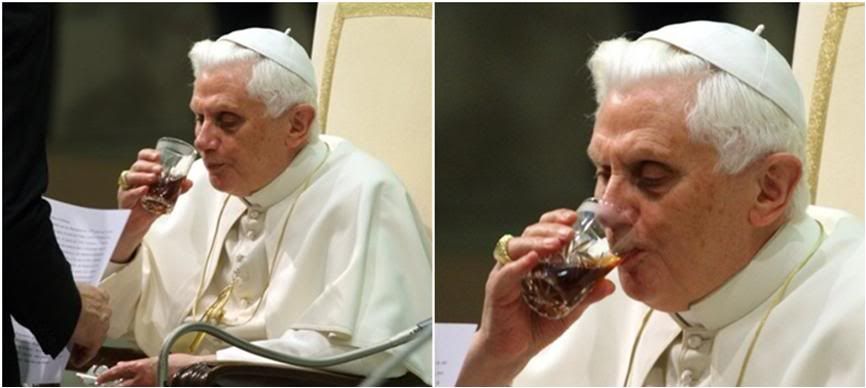
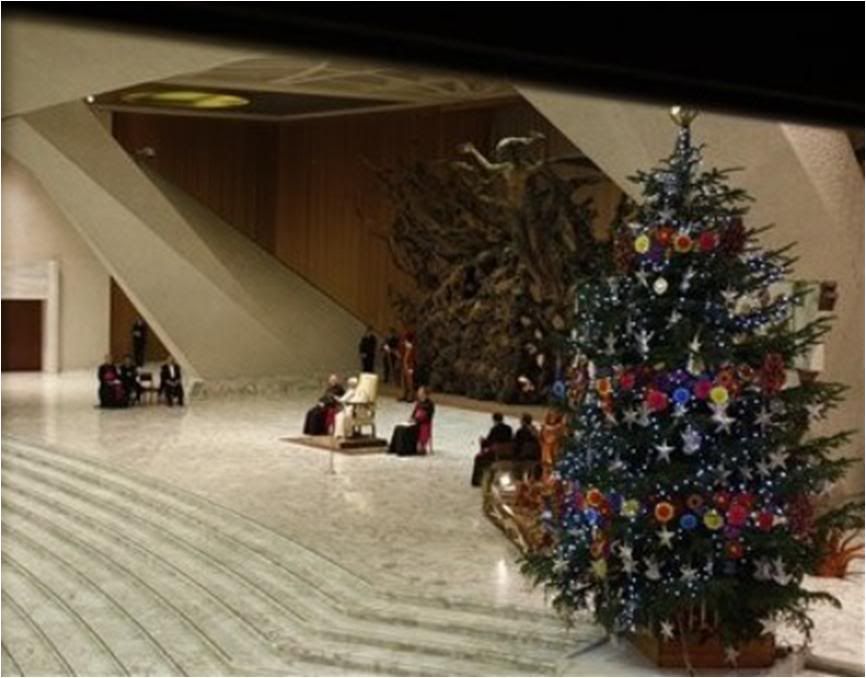
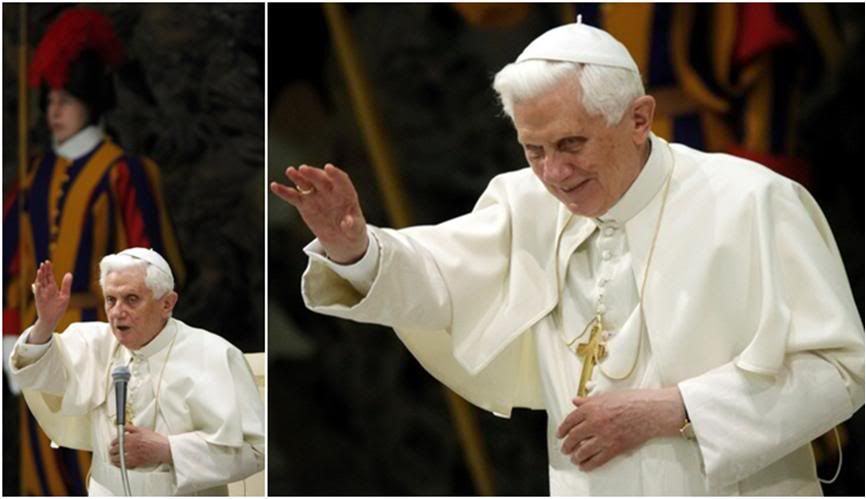
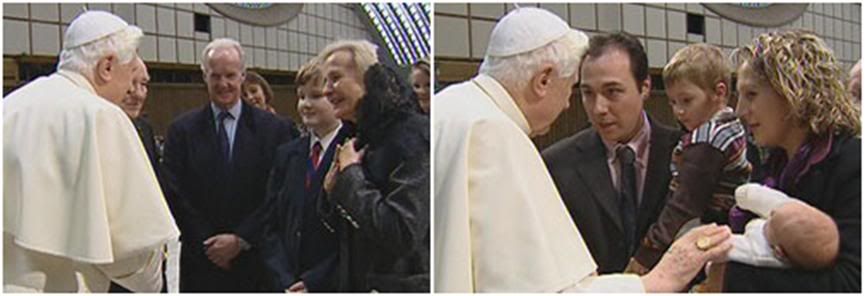 The Holy Father's comments about theologians reminded me of the recent death (on Christmas Eve) of one of Joseph Ratzinger's fellow experts at Vatican-II, the Dutch Dominican Edward Schillebeeckx, 90 - who ended up being warned repeatedly by Cardinal Ratzinger's CDF in the 1970s-1980s for his unorthodox teachings and writings, most notably that he claimed the Resurrection was not objective fact; besides that, he advocated married priests, independent bishops and the like.
The Holy Father's comments about theologians reminded me of the recent death (on Christmas Eve) of one of Joseph Ratzinger's fellow experts at Vatican-II, the Dutch Dominican Edward Schillebeeckx, 90 - who ended up being warned repeatedly by Cardinal Ratzinger's CDF in the 1970s-1980s for his unorthodox teachings and writings, most notably that he claimed the Resurrection was not objective fact; besides that, he advocated married priests, independent bishops and the like.
Paolo Rodari wrote a nice little article that pointed out how Schillebeeckx (more than Hans Kueng) was the principal advocate of Vatican-II as rupture with the past. I have been meaning to translate it, since the English articles I have seen so far are too 'respectful' to say that outright.
[Modificato da TERESA BENEDETTA 30/12/2009 20:24] |
| |
 30/12/2009 19:56 30/12/2009 19:56 |
|
| | | OFFLINE | | Post: 19.179
Post: 1.823 | Registrato il: 28/08/2005
Registrato il: 20/01/2009 | Administratore | Utente Veteran | |
|

 Rome rabbi says Pope's visit
Rome rabbi says Pope's visit
is a fundamental stage in dialog
Translated from

Dec. 30, 2009
The preparations continue for the Pope's visit to the Synagogue of Rome on January 17, the Day of Jewish-Christian Dialog observed in the past two decades by the Church in Italy and some other Western European countries with their respective Jewish communities.
It will be the third synagogue visited by Benedict XVI after Cologne in 2005 and Park East Synagogue in New York in 2008.
Soon after he was elected Pope in April 2005, Benedict XVI sent a message to the Chief Rabbi of Rome, Riccardo Di Segni, expressing his confidence in "the help of the Most High to continue dialog and reinforce collaboration with the sons and daughters of the Jewish people".
The visit will come 24 years after the historic visit of John Paul II to the Rome Synagogue, on April 13, 1986. But how will the Jewish community in Rome treat this event? Fabio Colagrande asked Rabbi Di Segni.
DI SEGNI: With the awareness that this is an important event, a fundamental stage in dialog, and with great expectation for everything that it could signify in terms of prospects for the general atmosphere between the two communities.
What did John Paul II's visit in 1986 mean for Jewish-Catholic relations?
Essentially, a wall of mistrust cane down - and we have felt that palpably in the succeeding years.
How would you read this visit in this respect?
As a gesture of continuity, first of all.
The Pope's visit will also come on the occasion of your observance of 'Mo'ed di piombo'. What is this significance of this occasion?
We must explain what it is first: there was an assault on the Jewish ghetto in Rome in 1793 by a mob, let us say, who saw the Jewish community as supporters of the rights promoted by the French Revolution.
It is called 'di piombo' [of lead] because as the assault started, the sky turned leaden and there was a downpour that extinguished the fire they had started in the synagogue, as well as the enthusiasm of the mob.
What significance is there in the coincidence? Obviously, we are in a different historical phase - there is no ghetto now nor repression of freedoms. Now we must look at the relations between Jews and Christians in a totally different way.
This visit will also take place one year after the rabbis of Italy decided not to take part in the Day of Dialog in objection to the Good Friday prayer. Is that issue now closed?
[I don't think that was the primary reason then. The decision was announced in late November or December 2008, and the last time the Good Friday prayer was at issue was during Holy Week and immediately after. The immediate pretext for the boycott was that a Vatican cardinal had likened the Gaza Strip to Nazi concentration camps. Then, there was Benedict XVI's explicit praise fo Pius XII for his wartime activities in remember ing the late Pope on the 50th anniversary of his death.
Also, the Vatican reporter should have asked the rabbi why they are making so much fuss over Benedict XVI's revision of the prayer when they were apparently satisfied with John XXIII's relatively cosmetic modification in 1962 - because they never raised the issue again until Benedict XVI issued Summorum Pontificum!]
Let us say that it is closed from the point of view of diplomacy. There is still a prayer called De conversione iudeorum. [Someone help! I think there is a 1982 Missal online, so I'll check this out later.]So, it was necessary to get clarifications, above all, at the local level.
But after Cardinal Bagnasco, in his capacity as president of the Italian bishops' conference, explicitly stated that the Catholic Church has no intentions to convert Jews, we have been able to consider dialog again, because frankly, any intention to convert is a wall that will block communication. [But Cardinal Kasper already said that very clearly in an article that apeaered in both Frankfuerter Allgemeine Zeitung and L'Osservatore Romano on Holy Week 2008!
But at this point, we will go forward, hoping that in the process, we will realize what we consider to be for the common good of all, on both sides.
With regard to clarification, Rabbi, a few days ago you said you appreciated the statement of Fr. Lombardi, Vatican press director, after the promulgation of the decree on Pope Pius XII's heroic virtues. How important was his clarification?
That clarification, I believe, was important and should be recognized for what it is and not downplayed. It was significant for clearing the air - it was a sign of the Vatican's sensibility for the Jewish reaction to the decree.
So you think that despite moments of divergences and opposition, the dialog can continue?
Absolutely. Because if we stop at the things that divide us profoundly, we will not get anywhere. We should think of the things that unite us, and leave the controversies to be discussed, as they need to be - but they should be discussed at the right time and with the appropriate calm.
But dialog also means discussion, which is necessary. If both sides think the same way, then there is no discussion. So differences are important in order to move ahead.
But beyond this, one must launch messages of brotherhood and commitment in behalf of everyone. The world is watching to see if we can get along. And that is the challenge, let us call it, that faces us in the context of this visit by the Pope.
[Modificato da TERESA BENEDETTA 31/12/2009 00:45] |
| |
 31/12/2009 11:10 31/12/2009 11:10 |
|
| | | OFFLINE | | Post: 19.180
Post: 1.824 | Registrato il: 28/08/2005
Registrato il: 20/01/2009 | Administratore | Utente Veteran | |
|
 It is somewhat daunting to think that we have already lived through the first decade of the third millennium - and awesome for us Benaddicts that half of that decade has been in the Pontificate of Benedict XVI, first Pope of the 21st century and of Christianity's third millennium!
The biggest Vatican stories
It is somewhat daunting to think that we have already lived through the first decade of the third millennium - and awesome for us Benaddicts that half of that decade has been in the Pontificate of Benedict XVI, first Pope of the 21st century and of Christianity's third millennium!
The biggest Vatican stories
of the decade

December 30, 2009
'Tis the season for end-of-decade countdowns, like “best baseball comebacks” and “worst fashion blunders.” In that spirit, this column is dedicated to the biggest Vatican stories of the first decade of the 21st century [based on the coverage they got in the American media, it must be pointed out, as Allen does belatedly a few paragraphs down!]
Usually these lists reflect somebody’s opinion, and they’re designed more to entertain than to edify. You rarely learn anything you didn’t already know, but the debates they trigger can be loads of fun, and I considered going that route.
For example: “Biggest Vatican stories that never happened,” including the resignation of John Paul II or a sweeping reform of the Roman Curia under Benedict XVI.
Another would be “most under-appreciated Vatican stories,” such as the fact that despite the Church’s reputation for strict uniformity, we now have a de facto policy of liturgical pluralism within the Latin Rite (the extraordinary form for the Tridentine liturgy and new Anglican personal ordinariates, assuming they ever get off the ground.)
In the end, however, I decided to take a more empirical tack, seeking to identify what really were the decade’s biggest Vatican stories in the American media market. I did two month-by-month keyword searches under “Vatican” using Lexis-Nexis, the most comprehensive on-line media database, one for headlines in major American publications and the other for mentions in transcripts of national radio and TV broadcasts. Both searches began in January 2000 and ended in December 2009.
Of course, “most covered” and “most important” are hardly equivalent terms, but at least we can say with certainty which Vatican stories of the past decade generated the most buzz in the United States -- making them most likely to shape the perceptions of the average American about what the Vatican and the Pope are up to.
At the big-picture level, the results should surprise no one. By a considerable margin, the three stories that topped the charts were:
•The sexual abuse crisis
•The death of John Paul II and the election of Benedict XVI
•The visit of Benedict XVI to Washington and New York in April 2008, the lone papal journey to the United States during the decade.
Of the three, the John Paul II/Benedict XVI story was easily the biggest.
In an average month during the last decade, there were roughly 71 headlines about the Vatican in the United States, but in April 2005, that number soared to 573. In the broadcast arena, the spike was even greater. Considering coverage in January, February and March of 2005, when John Paul’s illness was the lead global story, the papal transition accounted for a staggering one-third of all mentions of the Vatican by national radio and TV outlets for the entire decade.
Other stories that produced significant up-ticks were:
•John Paul II’s March 2000 visit to the Holy Land.
•The 25th anniversary of John Paul’s election to the papacy in October 2003, coupled with speculation about the next Pope.
•Pope Benedict XVI’s Sept. 12, 2006, lecture at Regensburg, which triggered a firestorm of protest across the Islamic world by appearing to link Muhammad with violence.
•Benedict’s June 2007 decision to authorize wider celebration of the old Latin Mass.
•Debates over the relationship between Catholicism and other religions (including a tough 2000 Vatican document titled Dominus Iesus and several investigations of theologians).
•The Vatican’s critical reaction to the U.S.-led war in Iraq in 2003.
•A 2005 Vatican ruling that homosexuals should not be admitted to seminaries, meaning that they should not become priests.
•Faith and politics, including the Vatican’s still-debated position on refusing communion to pro-choice Catholic politicians, and its openness to U.S. President Barack Obama.
•Catholic-Jewish relations, including stories that bookended the decade: The controversial beatification of Pope Pius IX in 2000, and movement towards sainthood for Pope Pius XII in 2009.
•Vatican reaction to two pop culture sensations: Dan Brown’s The Da Vinci Code and Mel Gibson’s “The Passion of the Christ.”
The two charts illustrate the spikes in print or broadcast coverage, or both, associated with each of these storylines.

While little of this is especially shocking, there are at least three interesting lines of reflection suggested by the data.
1. The Difference between Print and Broadcast
The most obvious impression that literally leaps off the two charts is that while the death of John Paul II and the election of Benedict XVI were only relatively more covered in print, it was a landslide winner in broadcast. The papal transition accounted for around ten percent of print coverage of the Vatican during the decade (narrowly edging out the sexual abuse crisis), but a full one-third of broadcast interest.
In a sound-bite, the death of John Paul and election of Benedict XVI was by far the greatest TV phenomenon of the decade, but only a relatively more compelling print story.
Other differences also emerge. John Paul’s October 2003 anniversary (which included a consistory for new cardinals) was a big broadcast story, but didn’t make much of a dent in print, while the opposite was true for the theological controversies ignited by Dominus Iesus in 2000 -- it was a big deal in print, but didn’t generate as much heat in the TV world. The two Holy Land journeys of the decade, John Paul in March 2000 and Benedict XVI in May 2009, produced jumps in broadcast coverage big enough to show up on the charts, but less so in print. (That’s especially true of Benedict’s trip.)
The explanation seems reasonably obvious: Stories with a dramatic visual and audio component are more likely to be widely followed by broadcast media, whereas stories about policy or theological disputes are more at home in the print world. [DUH!] The Vatican has always been adept at stagecraft, which makes it a natural for TV.
[Allen makes it seem as though 'the Vatican' stages its happenings - rather than that all the visible pageantry is the reflection and accretion of 2000 centuries of tradition, that its events will occur exactly the same way even if there was not a single camera to record them, because in the faith, the way it was is still the way it is, and the liturgy - the visible form and symbolic expression of the elements of the faith - reflects this. This is ritual, not stagecraft.]
Given that contrast, it might be an interesting exercise for a Catholic college to conduct a study of differences in perception of the Vatican and/or the Pope among Americans who are mostly dependent upon TV for their news (presumably, a substantial majority) and those whose outlooks are more shaped by newspapers and journals.
Though it’s no more than a working hypothesis, my hunch would be that people more attuned to broadcast media may have a slightly sunnier impression of where things stand. [Not just because of the conventional wisdom that pictures are far more efefctive than words, but because watching events happen as opposed to simply reading about them reduces almost all of the filtering and biases that shape printed stories. and enables the viewer to have his own impressions that are not derived second-hand from and therefore reflect some reporter or commentator's opinions. Even if, the choice of visuals shown and commentary accompanying a broadcast also act as filters between the event as it is and the viewer's perception of it.]
2. Impressions of Media Bias
Among some Catholics, it’s an article of faith that the secular media in the United States is hostile to the Catholic church. During the past decade, that conviction was solidified by the sexual abuse crisis, and amplified by the way the media sometimes cast the Church as a heavy in the culture wars over abortion and homosexuality.
Simply adding up the total number of references to the Vatican doesn’t distinguish between positive and negative coverage, but it’s worth noting that two of the three clear winners for biggest stories of the decade were, by common reckoning, good ones for the Vatican: the global outpouring of affection for John Paul II at the time of his death, and the visit of Benedict XVI to the United States.
Polls taken shortly after that trip showed the new Pope winning high marks for his candor on the sex abuse issue, including the first-ever papal session with victims, and for the image of basic kindness he managed to project.
CNN actually carried three papal events more or less bell-to-bell during Benedict’s American swing: a Mass at Nationals Stadium in Washington, D.C., a Mass at St. Patrick’s Cathedral in New York, and the concluding Mass at Yankees Stadium. That had to be a record for the most Catholic liturgy ever broadcast on an American commercial network in a single week. (As CNN’s commentator during those events, I can add a touch of personal astonishment that there’s actually money to be made simply by knowing the parts of the Mass!)
To be sure, the sex abuse story was a cancer for the Church, including the Vatican, which ran throughout the decade. Coverage in the decade pre-dated the American crisis, beginning with revelations in March 2001 (first reported in NCR) about the sexual abuse of nuns in Africa by priests, and a November 2001 apology by John Paul II to the church in Oceania for sexual abuse by priests and religious.
There were plenty of other negative storylines too, including fallout from Benedict’s Regensburg lecture and his decision to lift the excommunication of the Holocaust-denying (or, at least, Holocaust-minimizing) Bishop Richard Williamson.
Nevertheless, looking back at patterns of coverage over the last ten years, it’s difficult to sustain an impression of systematic anti-Catholic or anti-papal bias. On the whole, the press in this country seemed to cover the good with the bad -- and, based purely on statistical counts, the good (from the Vatican’s point of view) often seemed to prevail.
3. The Two Popes
Comparing the two popes of the decade, John Paul II is conventionally seen as the more charismatic media figure, and that’s certainly reflected in TV and radio coverage. [Allen's definition of 'charismatic' appears to be synonymous with 'what the media choose to cover'!]
Setting aside April 2005, when the two popes overlapped, John Paul was mentioned on American TV and radio an average of 89 times a month during the first half of the decade, roughly a 25 percent better clip than Benedict’s average of 66 references a month.
In print, however, Benedict XVI actually comes out slightly ahead. During the 63 months that John Paul reigned during the decade, the Vatican garnered 71.3 headlines a month, while over Benedict’s 56 months the average was 71.9.
Those numbers seem to confirm a bit of conventional journalistic wisdom, which is that while John Paul II was the ideal Pope for the TV age, the cerebral Benedict is often better suited to print.
{Such a generalization overlooks the fact that all Church events which involve ritual are inherently visual, and would be grist for the visual media (still cameras, TV and film) regardless of who is the Pope!]
My friend and colleague Delia Gallagher was, I think, the first to say that Benedict XVI is a great Pope for the Internet, because he’s meant to be read, and virtually every word he either speaks or publishes is now available in real time.
Here’s a final impression, which I can’t confirm statistically, but it reflects my experience: Much coverage of John Paul II during the first half of the decade was cast either in the past tense or the future, while Benedict’s is more firmly in the present.
That is to say, a dominant storyline regarding John Paul II from 2000 to 2005 was the health watch. (I used to grouse that I lived for the day when I would never again have to begin a TV bit with the phrase, “Well, I’m not a doctor, but …”) Much print and broadcast coverage was either retrospective, looking back at John Paul’s legacy, or trying to peek ahead at what (and, inevitably, who) might come next. [A most lamentable tendency, obviously, even if a natural tendency for media which prefer material that is outright negative or has any potential for being 'sensational' - resulting in a lopsided coverage of John Paul II's final years.]
A much greater share of Benedict’s coverage has been rooted in the here-and-now. He’s been in office less than five years, so legacy pieces are premature, and there’s been no health scare to kick-start speculation about a successor.
While he’s amassed a mixed record as a communicator, at least his major stories have been about substantive issues: the “clash of civilizations” between Islam and the West, his battle against a “dictatorship of relativism,” Christian-Jewish relations, faith and politics (including the relationship between the Vatican and the Obama administration), and so on. [A 'relationship' that is being given unwarranted significance by American reporters and commentators - as though what an American administration does could influence the doctrine of the faith, or that relations between the Vatican and the US were any more significant than relations between the Vatican and the European Union!]
In other words, we’re in that “sweet spot” within a papacy in which the focus is on ideas [I wish!]-- we’re beyond profiling the new guy or summing up his early moves, but not yet ready for obits and prognostications. Moreover, that sweet spot could last a while, since there’s little indication that Benedict XVI is on the brink of decline.
[The 'focus on ideas' by the media is false and illusory because the 'ideas' that they play up are not so much ideas as 'issues' - they are not itnerested in the ideas as such, but only if and when any 'idea' happens to stir up conroversy, and then, they apply to it a fanatic tunnel vision that blots out everything else about the issue other than what they are interested in. The Regensburg lecture is the most illustrative case in point.]
As I’m fond of saying, German machinery is built to last. The way Benedict XVI rebounded from that collision on Christmas Eve would seem to suggest he’s remarkably resilient for a guy of 82 … but, of course, I’m not a doctor.
[Allen could not resist adding his final colloquialisms. To look at Benedict XVI as 'German machinery' is offputting, to say the least, and to add 'but, of course, I'm not a dcotor' at the very end unnecessarily casts a dubious pall over the observation that the Pope is 'remarkably resilient for a guy of 82'!
And since Allen's basic criterion for drawing up his list was the amount of coverage an event had in the American media, while he listed the 25th anniversary of John Paul's Pontificate as one of the top events, he did not even mention the Jubilee Year of 2000 - marking the second millennium of Christ's birth, only the second time ever that a millennial milestone could be marked by any institution in the world!
What the Vatican put into planning and executing all the Rome-based events alone for Jubilee year was mind-boggling! I was living in Rome in 1999-2000, and the entire city infrastructure was renovated and updated for the Jubilee in a way Rome had not seen since it prepared for the Olympics. Not to mention the understandable flood of Jubilee keepsakes and memorabilia for an event that will not be repeated until another thousand years!
[Modificato da TERESA BENEDETTA 31/12/2009 11:29] |
| |
 31/12/2009 13:18 31/12/2009 13:18 |
|
| | | OFFLINE | | Post: 19.181
Post: 1.825 | Registrato il: 28/08/2005
Registrato il: 20/01/2009 | Administratore | Utente Veteran | |
|


 Thursday, December 31
Thursday, December 31
 Second from left: Icon showing Emperor Constantine and Pope Sylvester I.
ST. SYLVESTER (Pope Sylvester I, 314-335
Second from left: Icon showing Emperor Constantine and Pope Sylvester I.
ST. SYLVESTER (Pope Sylvester I, 314-335
For one of the longest-serving Popes, who served during the reign of Emperor Constantine, so crucial to the survival and propagation of
Christianity in antiquity, very little is known about Sylvester as a person, not even when he was born, though it is known his father was
a Roman native. During his time, the Church emerged from the catacombs, the great basilicas Saint John Lateran, Saint Peter’s and
others were built, and the Council of Nicaea was held [which dealt with the Arian heresy once and for all] - all of them made possible
because of the Emperor. But it has been noted that only a great and wise Pope could have served for almost a quarter-century in these
circumstances, helping to build the Church spiritually and materially in many fundamental ways. His feast falls on the seventh day
of Christmas. In the German-speaking countries, New Year's Eve is popularly called Silvesterabend, and celebrations greeting the New
Year are called St. Sylvester parties.
OR today.
 Illustration: Pierre Lombard, miniature from a 12th-cent. manuscript.
At the General Audience, the Pope speaks on the theologian Pierre Lombard and expresses his wish for
'A new year of friendship with Christ in order to be men of peace'
Other Page 1 stories: The Pope's condolences on the death of the emeritus archbishop of Tokyo, with a substantial
Illustration: Pierre Lombard, miniature from a 12th-cent. manuscript.
At the General Audience, the Pope speaks on the theologian Pierre Lombard and expresses his wish for
'A new year of friendship with Christ in order to be men of peace'
Other Page 1 stories: The Pope's condolences on the death of the emeritus archbishop of Tokyo, with a substantial
obituary inside; a commentary about the decade it calls 'nameless, which starts out calling it the 'noughties' (after
'nought' or zero), implying it was empty, and ends up being a little essay on Obama as the emblem of the decade
(though the writer certainly does not think he is 'empty') - singularly remarkable in that the essay makes no reference
at all to events within the Church during the decade - which included the Great Jubilee of 2000 and an epochal papal
transition - but I have stopped being nonplussed by the erratic editorial judgments prevailing at OR. Among the inside-
page stories: 37 Catholic pastoral workers (including 30 priests) were killed around the world in 2009 - almost double
last year's toll and the highest in 10 years.
THE POPE'S DAY
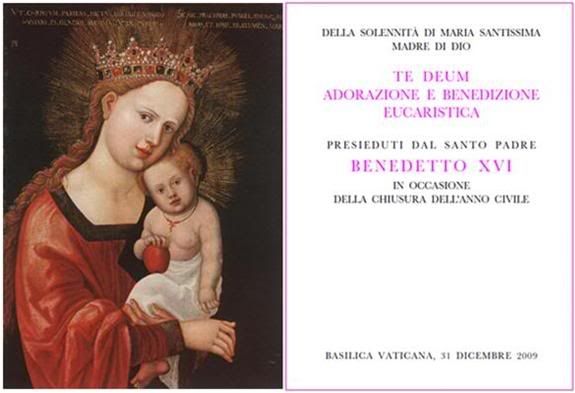 Vespers today and Thanksgiving Te Deum for 2009
Vespers today and Thanksgiving Te Deum for 2009
Eve of the Solemnity of Mary, Mother of God
5:30 p.m., St. Peter's Basilica
In just a few hours, it will be 2010 in the Southern Hemisphere!

[Modificato da TERESA BENEDETTA 31/12/2009 13:36] |
| |
 31/12/2009 13:32 31/12/2009 13:32 |
|
| | | OFFLINE | | Post: 19.182
Post: 1.826 | Registrato il: 28/08/2005
Registrato il: 20/01/2009 | Administratore | Utente Veteran | |
|
I have no time to translate the article now, but Il Foglio today has a story about Cardinal Camillo Ruini, retired president of the Italian bishops' Conference:
Namely, that the 77-year-old cardinal, who possesses political skills as adept as his philosophical and theological gifts are astute, has been chosen by Pope Benedict XVI to write the meditations and prayers for the 2010 Via Crucis at the Roman Colosseum, to head the Vatican Commission to evaluate Medjugorje, and to head a Vatican foundation to oversee the use and propagation of Benedict XVI's papal writings.
Can't get more 'high-profile' than that in the Vatican!
|
| |
|
|
|
|